 Mouth of The River
Mouth of The River
 Mouth of The River
Mouth of The River
TABLE OF CONTENTS
Sports & Culture
Return to School pg.4
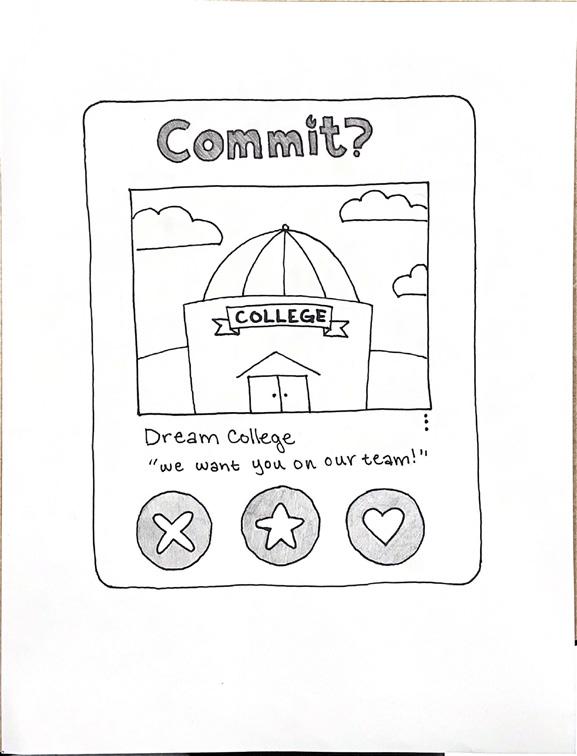
Damn Dam pg.6 Pledge pg.8
Senior Core pg.10 Mill Plaza Housing pg.12


Understaffed Restaurants pg.13
Art Department Thrifting Family Recipes
Noe Caffeine Summer Travel pg.24
Dear Reader,
Athletes Committing pg.28
We are super excited to be launching our first print edition of Mouth of the River for the 2021-2022 school year! After a year and a half of navigating the challenges of designing, producing, and distributing our magazine in a virtual environment, we are thrilled to announce the debut of our first Mouth of the River issue back in person since the 2019-2020 school year.
This issue is filled with a variety of interesting, entertaining, and serious stories that highlight both the successes and struggles of the community shifting back to an in-person setting. This year’s staff is particularly special since we, the Editors in Chief, are the only returning members. Despite the inherent challenges that come with learning the ropes to the MouthoftheRiverprocess, the staff has brought so much positivity, persistence, and enthusiasm to the production of our magazine and we could not be more thankful for it. We all look forward to reviving Mouth of the River staff traditions and continuing to serve as the voice of the student body at Oyster River High School.
Our cover story, “The Caffeine Controversy” written by Laura Slama, unravels the long-disputed truth of whether coffee is actually healthy or not. As something that the majority of students and members of the community can relate to, this seemed like an appropriate story that ties us all together. With the help of the creative team’s inspiration, the cover photos were captured by Hannah Muessig. Flipping through the rest of the first issue, you will find a diverse collection of articles ranging from a light-hearted recap of student travels to a heavier opinion piece on how to have more compassionate political conversations. Be sure to check out our online exclusive “Mac and Cheese Review” on YouTube to hear about Mouth of the River’s top picks for cheesy mac in the Seacoast area.

We are incredibly proud and thankful for our staff for being so involved and excited about creating this first issue. We also couldn’t have done it without the help of Mr. Kelly, who has guided us every step of the way. Lastly, we would like to thank this issue’s sponsors for being so generous to help fund our publication. You can check them out at the back of the magazine, as well as on our website! If you are interested in sponsoring MouthoftheRiverfor the following issues or would like to subscribe to the magazine, contact us at mouthoftherivermagazine@gmail.com.
Thank you so much for picking up the first issue of this magazine and we hope you enjoy reading the work of our amazing staff!
Sincerely, Bhavana Muppala and Laura Slama, Co-Editors in Chief
Meet the Staff
Curated by Hannah MuessigBhavana Muppala (‘22)
Bhavana is a senior, as well as one of the Editors in Chief and a returning member for MOR. Bhavana likes to keep herself involved in school activities. She is a member of SALT, FLBA, as well as indoor and outdoor track. Bhavana loves the outdoors, but you could never catch her there in the winter due to her intense hate of cold weather. In the summer however, you can find her on beach trips or getting ice cream with her friends. In the future, Bhavana plans on a public health major, getting her on the premed track to becoming a doctor some where warm.

Laura Slama (‘22)
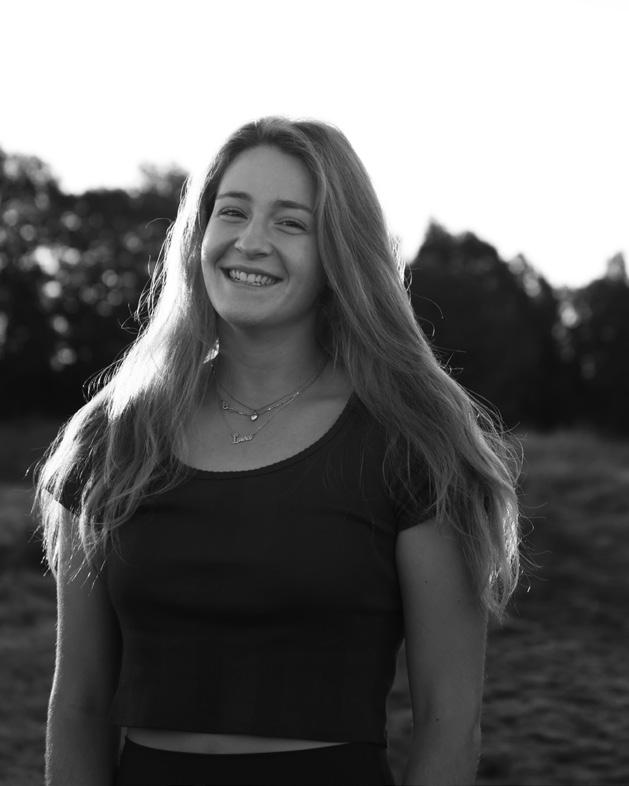
Laura is a senior, as well as one of the Ed itors in Chief and another returning member for MOR. Since freshman year, Laura has had the goal to be on the staff of MOR. She joined to share her perspective and thoughts with the community. When not writing articles, Laura can be found spending time with her family and two dogs, Mia and Anani. She also enjoys ex ploring her culinary skills, which includes try ing lots of new recipes. Outside of the kitchen, you can find Laura in the net as the girls Var sity soccer teams goalie. Laura wants to attend college in Florida, majoring in marine biology.
Mouth of the River Mission Statement
Mouth of the River seeks to reliably inform the student body, as well as the surrounding community, of interesting and newsworthy content in a modern, compelling format. Our goal as a staff is to give voice to the students of Oyster River, and have it heard by all our students. The opinions expressed in Mouth of the River represent those of the writers and staff.
Tess Brown (‘23)
Tess is a junior, as well as the News Editor for MOR. Outside of editing, Tess can be found playing both Unified Soccer and Volleyball. She enjoys time with her friends doing all kinds of ac tivities. She also enjoys thrifting and all things spooky. She has a dog named Emmet too. In the future, Tess wants to focus on a career in psychology and wants to make sure to have writing of any kind involved while hope fully studying at Salem State in Massachusetts.
Lauren Hoppler (‘22)
Lauren is a senior this year, as well as the Op-Ed Editor for MOR. Out side of the newsroom, she enjoys time with her chubby, orange tabby, Hazel as well as spending time with family and silly adventures with friends. Lauren as well has a secret talent for juggling. In her future, her main priority is to be happy, as well as have fun.
Zoe Selig (‘23)
Zoe is a junior this year, as well as the Features Editor for MOR. In her free time, she enjoys walking her dogs, Scout and Jazz in ORNA. She also enjoys working with the Justice Equity Diversity Inclusion Committee. Zoe sees herself working in a ca reer where writing is definitely involved.


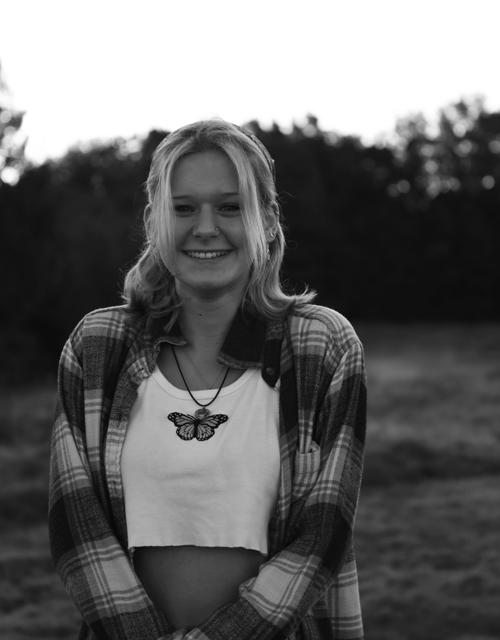



Libby Davidson (‘23)
Libby is a junior, as well as the Layout Editor for MOR. When not diving into new leads, Libby can be found diving into the pool, swim ming for the Seacoast Swimming Association. She also enjoys ex perimenting with her baking skills and spending time with her three corgis, Maisy, Baxter and Poppy. Journalism 1 was one of her favor ite classes she’s taken at ORHS and Libby loves the journalistic style of writing. In college, Libby hopes to be a part of a swim team, working on her skills.
Annie Doherty (‘22)
Annie is senior this year, as well as the Business Manag er for MOR. In her free time, Annie works at a Barrington After School Care program as well at the New England Dragway. She enjoys reading, practicing Tarot Cards, as well as practicing horseback riding and dance. In the fu ture, Annie will be going to school for nonprofit manage ment.
Evy Ashburner (“22)
Evy is a senior, as well as the Business Manager for MOR. When not managing budgets or the quarterly Coffee House, she’s running the Oyster River Dance Team, a team she founded. Evy founded the Women’s Rights Club, and is a senior member of the Sustainability Club. She loves baking, specifically cup cakes and cookies and drinking iced chai lattes. She also actively does aerial dance. In the future, Evy wants to work in the fashion business when she is older.
Caitrin Ferris (‘22)
Caitrin is a senior, as well as the Multimedia Editor for MOR. Cai trin is the owner of two pets, a cat named Sochi, and a dog named Loki. She has two younger sisters as well. In her spare time, you can find her on the lacrosse field, or at the beach. She loves the color green and mint ice cream. Caitrin joined MOR to build her skills as a writer, as well as write stories important to her that she could share with the community.
Hannah Muessig (‘22)
Hannah is a senior this year, and is in charge of the Photography and Art for MOR. Hannah is an active cross coun try runner for the school’s team, as well as a pro on many different instruments. She has an active love for photography, specifically landscapes and portrait photography. She prioritizes her aca demics and friends. She hopes after at tending college to work in a field of bio med, physical therapy, or public health communications.
Jen Newick (‘22)
Jen is a senior this year, as well as the Sports and Culture Editor for MOR. Jen plays three sports, which includes field hockey, softball, and ski racing. She spends her free time with her fam ily boating, as well as heading up north on her weekends and spending time with friends. She wants her college education to focus on exercise science, as well as earning a masters in athletic training.
Emily Jackman (‘22)
Allan Rucker (‘23)
Allan is a junior, as well as the Mar keting Manager for MOR. Outside of MOR, Allan enjoys being out on the slopes snowboarding. He also enjoys being with his pet python, Kaa.

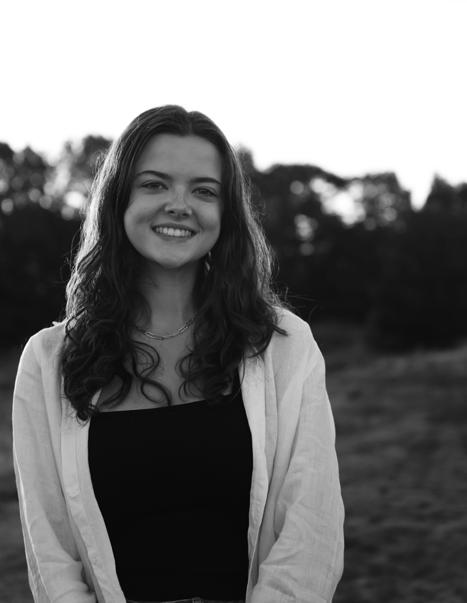
Emily is a senior, as well as the Digi tal Manager for MOR. She enjoys her free time with painting, shopping, as well as working with kids. Someday in the future, she plans to be a teach er, while at the same time, working to receive the credentials needed to become a school psychologist.
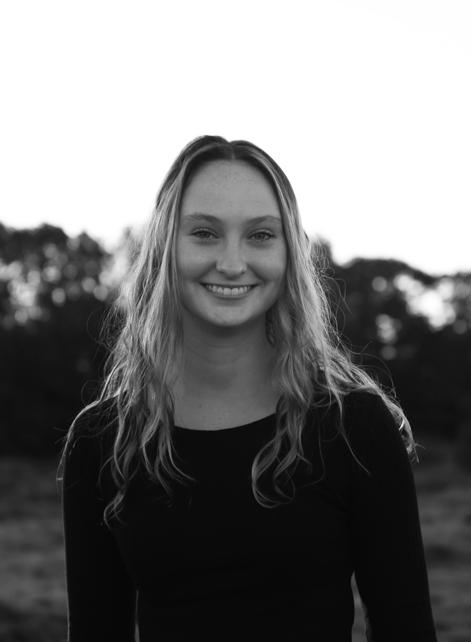
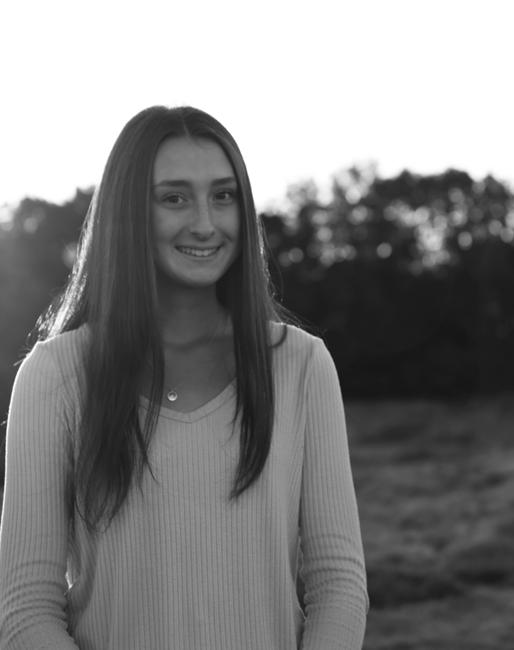
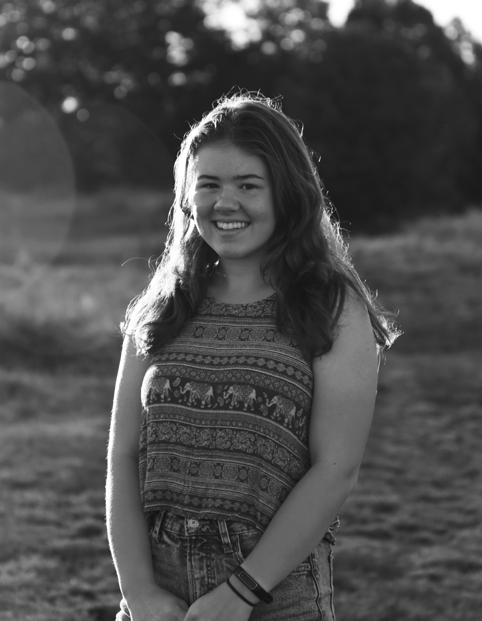
Getting Back School Spirit and an Academic Load
Emily Liu (‘23) walks through the halls, class to class talking and laughing with classmates that she hasn’t seen in the time of remote learning. She is motivated by her peers and has a full course load of challenging classes that she is taking this year. However, underneath all that excitement of having a “normal” high school year, there is some nervousness about getting be hind. Students alike are scared this year will bring a heavy load of school work and a packed schedule leading to exhaustion.
Some Oyster River students were remote for almost two years now. All the classes, other than seniors, have not experienced a full year of high school yet. Now that students are in the building, there are more opportunities to be social, take part in clubs, and go to events. With these opportuni ties, there will also be an increased commit ment level than in past years done remotely, including a nightly homework routine. As students adjust or begin to experience high school experiences in person, both students and teachers expressed their concerns, excitement, and tips on making this a great year.

In the first few weeks of school, there has been visible ex citement and success expressed by students and teachers. Jason Baker, a school counselor said, “I’ve seen excitement. I’ve seen it from kids [and] I’ve seen it from adults. There’s definitely a feeling of our motto this year: better together... Our educational system was founded on being in person and we didn’t realize that alone. We never talked about being together [before].”
Students and teachers realized how much they missed some elements of being together as a school community, especially in the first few weeks of school. Many are excited to be getting back classroom connections and to be in a more productive learn ing environment. Maya More (‘25) is very excited to be back to in-person learning to begin to experience high school. She explained that expectations are higher than in remote middle school, but with that, it’s also been a much more motivating and productive environment for her to learn. More said, “I really struggled with remote learning. It did not work well for me. I wasn’t able to keep up with my work well. That was hard.” She continued, “it’s a lot easier to focus [being in person].”
Back in person, many students are gaining new motivation from seeing other students and working together. In general, eating lunch with friends, working on assignments together during class, and just walking by other students in the hall has made school a lot more enjoyable for many students.
J Ruml (‘22) shared their excitement to work with people again. “It’s been really great to come back to school because I’m just seeing a wider variety. I didn’t talk to that many people over quarantine, so especially the first few days have been fun to see all my friends and not just all the ones I’ve been talking to a ton.” Although all these new changes are exciting and beneficial for many students, there is still some worry that work and social life will become challenging. In the first couple of weeks, students reported fairly well balanced school days, but since so many students have not experienced a full year of in-person school at the high school, there’s some uncertainty of what’s to come. Liu explained, “I think I’m both excited and worried because it’s my first time in a whole year compared to how freshman year was cut off, and sophomore year for me was completely remote. I’m worried that I’m not used to the new workload.”
Celeste Best, a science teacher, heard this worry from many of her students. Best and other teachers understand that students will have to adjust to this change and the goal is not to make this a challenging year. With this in mind, teachers are still going to try to teach a full curriculum to get back on track and preparing students for their futures. Best explained, “I think we are going to have a normal workload. I don’t think anyone is going to try and make up for things you didn’t get to… I think students are going to have to get back into that mode of having nightly homework and you are going to have to spend time [doing a little more work]. I think students are going to have to get used to deadlines because those are going to be relatively solid.”
Students will have to work at full curriculum speed, but this workload can be gradually increased over time based on stu dents’ needs in adjusting to a new workflow. Baker explained, “we understand we need to build up the tolerances and momen tum. Sure, it’s still scary, but we are going to gradually increase.”
Along with that, teachers put a lot of thought into their curriculums and how they are going to teach students so that they can adjust to a full workload and go over things that were missed in past years. Teachers hope that students will com municate if they didn’t learn assumed knowledge. In the math department, this adjustment is especially important because math is a foundational topic. Lisa Halbach, the math department director stated, “we tried to be very careful in terms of how we did it [changed the curriculum]. We are not out to try and make this year challenging. This is not going to be a one-year process.”
Although there are some skills and pieces of the curriculum that teachers didn’t get to, Best and Hallbach said that students aren’t ac tually behind. Skills that weren’t learned have been replaced by other important skills stu dents learned by being remote. Students agree that they’ve gained new insights on their learn ing and have picked up skills that can be helpful for this year and future years. Students from all grades with individual experiences in remote learning share their gained skills from remote learning that will help them with this new year.
Ruml shared that with remote learning they learned a lot about what they need to do to take care of their mental health. They had more time to reflect on themselves and their identity. “I know myself so much better and I know my learning better. I know how to not exhaust myself,” they said
Liu also benefited from quarantine in some ways. She ex plained that teachers weren’t over her shoulder telling her what to do and she learned how to problem solve and figure out some information independently. “I think I gained the ability to work on my own and teach myself information.”
Similarly, Talia Banafato explained that she was forced to learn how to organize all her commitments. “I think I can manage my time better from remote learning, so I think that will help with my work now. ”

Students can find a lot of success this year if these following skills are carried over this school year. Teachers such as Best and Hallbach suggest that students make sure to communicate with teachers and reach out if something is difficult. Best stated, “Flex times, which we didn’t have [last year], I think are going to be really important for kids as they start to get into things... I think it’s the communication piece with your teacher and your parents that is going to be really key to time management and figuring
out the things you need to do.”
Hallbach stated the importance of using resources and being on top of your schedule. “Don’t get behind. Continue to get your homework done on a daily basis. Come see your teacher during flex or if you have a free period or study hall, and there’s always a math lab. [There are] lots of options to get support so you can be successful.”
If the nightly homework sneaks up on students or the com munication piece gets difficult, it’s important to talk to an adult who can help break things down.
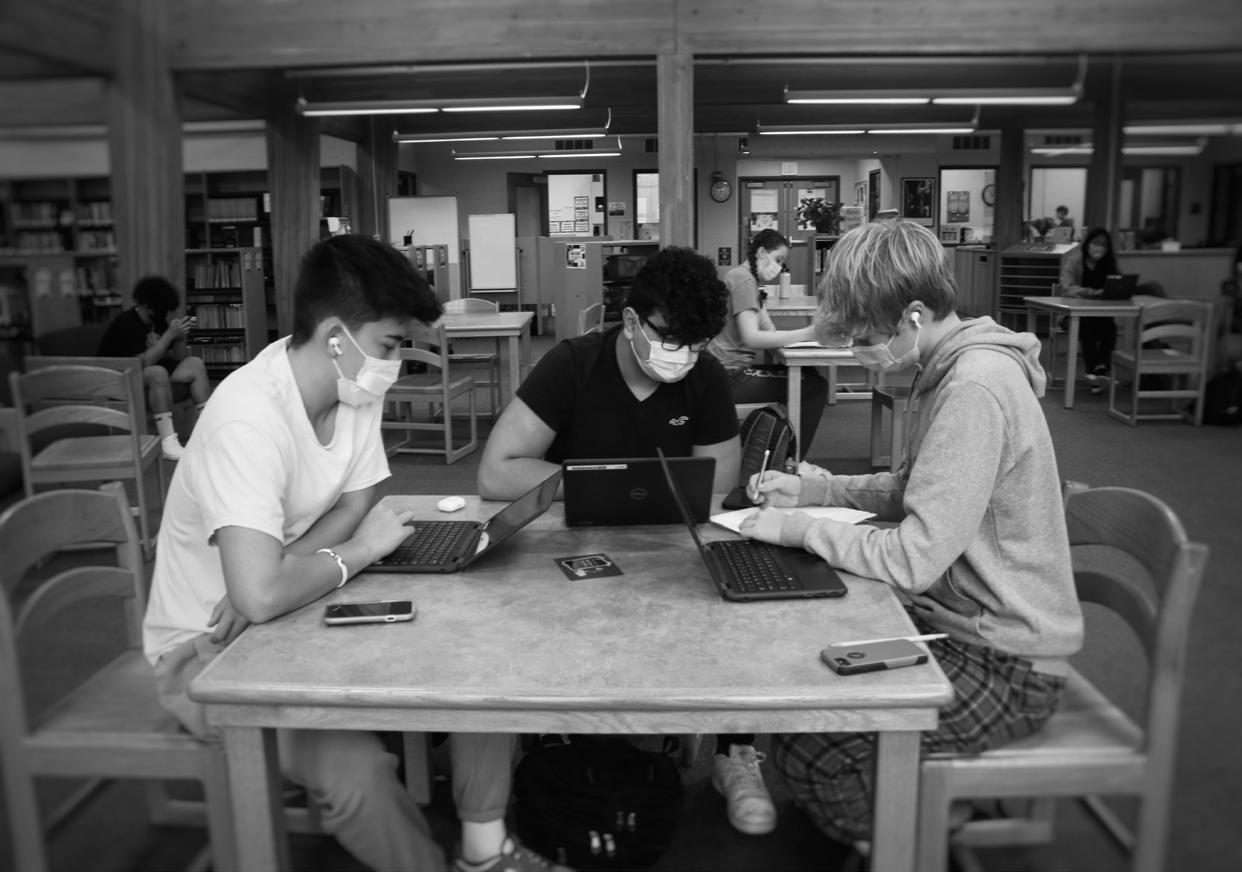
If students and teachers can communi cate and connect again hopefully students will get all caught up on school curriculum, events, and get through the stressful moments that may come. Liu really believes that connecting with her peers is key to getting through the challenges school brings. “[During remote learning] I felt I was really disconnected from the people around me and the students in my class.”
She continued to explain that this was very demo tivating at times for her, but being in the building has helped her to be very motivated. “I feel like because I’m in school with all my peers around me with all my friends, I feel more motivated to do work and to actually turn in homework and do [well].”
Being together and communicating with others is not only important for academics, but also for school spirit and the high school experience. Best said, “I think things like spirit week are going to be fun... So now you have that opportunity to bring that culture back. You know that [this year’s] theme is better together, absolutely. I didn’t realize how bad last year was until I got back here. I knew it was bad and it was crazy... but I didn’t realize how much I missed that student interaction until I could actually see your eyes and stuff like that.”
Baker added, “now is the time for students to get back to those traditions they love, for people to know what high school actually feels like, carry over skills like time management, and focus on mental health.”
If students continue to have positive energy and excitement about being back together, this could be a really great year. That alone has provided a lot of support so far. Students and teachers hope everyone can remain healthy and that this time we can work through new changes all as one, not separated by screens.
- Hannah MuessigThe Damn Dam
In the year 2000, the Mill Pond dam was classified as a “sig nificant hazard structure” in a state inspection. For years, the Durham town council debated whether to remove or repair the dam. It wasn’t until Monday, September 13th, 2021, when the decision was finally made.

21 years ago, when Durham was given this warning, the town was essentially told: “do something about it.” Scot Calitri, one of the founding members of the Oyster River Conservation Alliance (ORCA) said that Durham hired VHB, a consultancy that specializes in situations like this. They analyzed the problem and gave the town possible solutions and outcomes for what they could do with the dam. From the information provided by VHB, the town chose two alternatives to be further studied. The town council and citizens of Durham ultimately came to the conclusion that the Mill Pond dam either had to be removed, or repaired.
Pele Harrison lives on the Oyster River, less than a mile up from the dam. She’s lived there her whole life and never thought she would see it go. Harrison was in support of keeping the dam, as she believes that the dam is a staple in Durham’s town history, as well as a landmark that we will lose. Harrison said “I was dis mayed to learn that so many people want to remove the dam. I don’t understand how they could want to destroy one of the most iconic, his toric, and beautiful features of Durham and the environ ment it creates.”
Mill Pond has held a big role in the Durham com munity as a sort of common area for people who live nearby. In many Durham town council meetings, citizens spoke up about how the Mill Pond is an important place for the community, and they are worried we will lose that if the dam is removed. Some of the comments emphasized the activities that waterfront homeowners partake in. In the past, the pond was used for ice skating, playing pond hockey in the winter, and kayaking in the summer. There are some picnic tables, walking trails, and a little footbridge that you can walk over.
One of the biggest concerns for repairing the dam is the cost, which includes dredging of Mill Pond. Dredging is the action of cleaning out the bed of a harbor, river, or other area of water by scooping out mud, weeds, and rubbish with a dredge. Along with the dredging would come sediment removal to clear out
the water and whatever dredging left behind, and, of course, increasing the cost of the removal. VHB estimated about 5 mil lion dollars for the entire process, none of which is a permanent solution. But to many citizens who own property on the river, the 5 million spent to repair is much better than the loss of their waterfront property value.
It seems that the majority of the people who supported removing the dam were most concerned about the ecological damage the dam has caused. Melissa Pley, Great-Bay Piscataqua Waterkeeper, at the Conservation Law Foundation, sent an email to the Durham town council in March 2021. The email outlined the science behind the dam removal argument. Pley included the poor health of the estuary, low oxygen levels that can’t be solved by dredging, and how the history of the Mill Pond estuary starts long before the dam, with the indigenous peoples that harvested the migratory fish.
In a youtube video called “Restoring Our Water and Food Ways of N’dakinna (Our Homelands),” Paul and Denise Pouliot, members of the Cowasuck Band of the Pennacook-Abenaki People, talk about the indigenous culture of the area and their views on the Mill Pond Dam. Paul Pouliot said, “We like to honor not only the land but the waterways, the air, the flora, the fauna and all the things living in N’dakinna. They sustained us through thousands of years. 12,000 years in this par ticular place called N’dakinna.” The Pouliot’s have been engaging people in the Durham community doing environmental and social justice projects since 2008. The Pouliot’s are in strong support of removing the dam and restoring the land to its natural state. Paul Pouliot said “ This town should really wake up and realize [we’d be] spending more money to preserve this or reconstruct this colonial suppres sion…I’d rather see water flowing here, and all the migratory birds come back here once these are wetlands again, once this is purged of all the pollutants your going to see a robust ecosystem come back.” Paul ended with a powerful statement preaching the importance of listening to science and remembering that Durham’s history does not start at the dam.
Micheal Dionne, a Marine Biologist with New Hampshire Fish and Game said, “If the dam is removed, the Mill Pond will disappear and the system will become riverine habitat. Bathym etry (the measurement of the depth of water in oceans, seas, or lakes) performed by VHB shows that at least several hundred
feet of the river will become tidal. So at least some of the former Mill Pond will become estuarine much like what exists below the dam currently.”
The Mill Pond dam has been in Durham for decades so naturally, the ecosystem grew on either side of the dam. On one side the dam is a tidal marsh and the other is the pond. At this point, the pond is more algae than anything, but the Oyster River and Mill Pond support birds, fish, otters, frogs, turtles, plants, and many other animals. One of Harrison’s concerns is that we will lose more habitat than we will gain during the restoration of the dam. She believes that because the town council decided to re move the dam, citizens will lose trust in the town council and feel betrayed in some ways. She added, “Once down, they can never repair the damage done and the space that once was the Mill Pond will be a depressing reminder of their decision.”

To marine biologists, scientists, and many Durham residents, removing the dam seems like the logical choice. It would return the river to its original state and allow fish that used to migrate here to come back. After all the studies done by VHB, local scien tists, and companies, a major part of the decision came down to the cost. Removing the Mill Pond Dam was estimated at around $1.3 million in the VHB report, almost two times less than repair ing the dam.

Jon Bromley, a science teacher at Oyster River and Durham citizen, is in full support of removing the dam. He said “From an
environmental standpoint, from an economic standpoint, an eco logical standpoint, and a historical standpoint, it all points to the ‘dam’s life is over’. It’s time for it to come down.” Bromley contin ued saying that to try and re pair it is simply postponing the inevitable, that the dam will come down. Bromley said that while the dam does hold a historical connection to Durham, there are ways to preserve the history with things like signage to commemorate it, but the ar gument on the history is shortsighted. “There’s a whole lot beyond our little colonial history, and in this day and age, it’s important to be increasingly mindful of [that].”
The recent pushback from the town has begun to increase only days after the decision was made. Durham town citizens have not held back from expressing their opinions to the leaders of the community. Many have become skeptical of the science done by the consultancy VHB. In town meetings, citizens have said that VHB is reporting biased reports that encourage the removal of dams. Many townspeople have set up protests and petitions to make the decision move to a town vote rather than a council decision after the 21 years of debating. The people of Durham are now being faced with the decision to either destroy a historic landmark to return the natural flow of the oyster river estuary or save the dam but spend more money for an impermanent solution for Mill Pond.
“Once down, they can never repair the damage done, and the space that once was the Mill Pond will be a depressing reminder of their decision.”-Evy Ashburner Photography by Hannah Muessig
Please Stand for the Pledge... But Will You?
Every morning, students in the Oyster River School District are greeted with directions to stand and pledge allegiance to our country. However, some students have found flaws to this national pledge and have chosen instead to remain seated.
Being back in school, students have started to argue over whether or not you should stand for our nation’s pledge. Many believe that the wording of this old fashioned pledge is outdated or certain parts don’t apply to our country and the current status of how we are living in 2021. However, a large group of students also believe that not stand ing shows disrespect to our country as well as peo ple who fought for freedom in our country. With a recent increase in opposite opinions in both our school and country, it’s no wonder so many people have become divided over this issue. Some believe it’s just to stand, some believe it’s wrong to stand, and some are staying neutral.
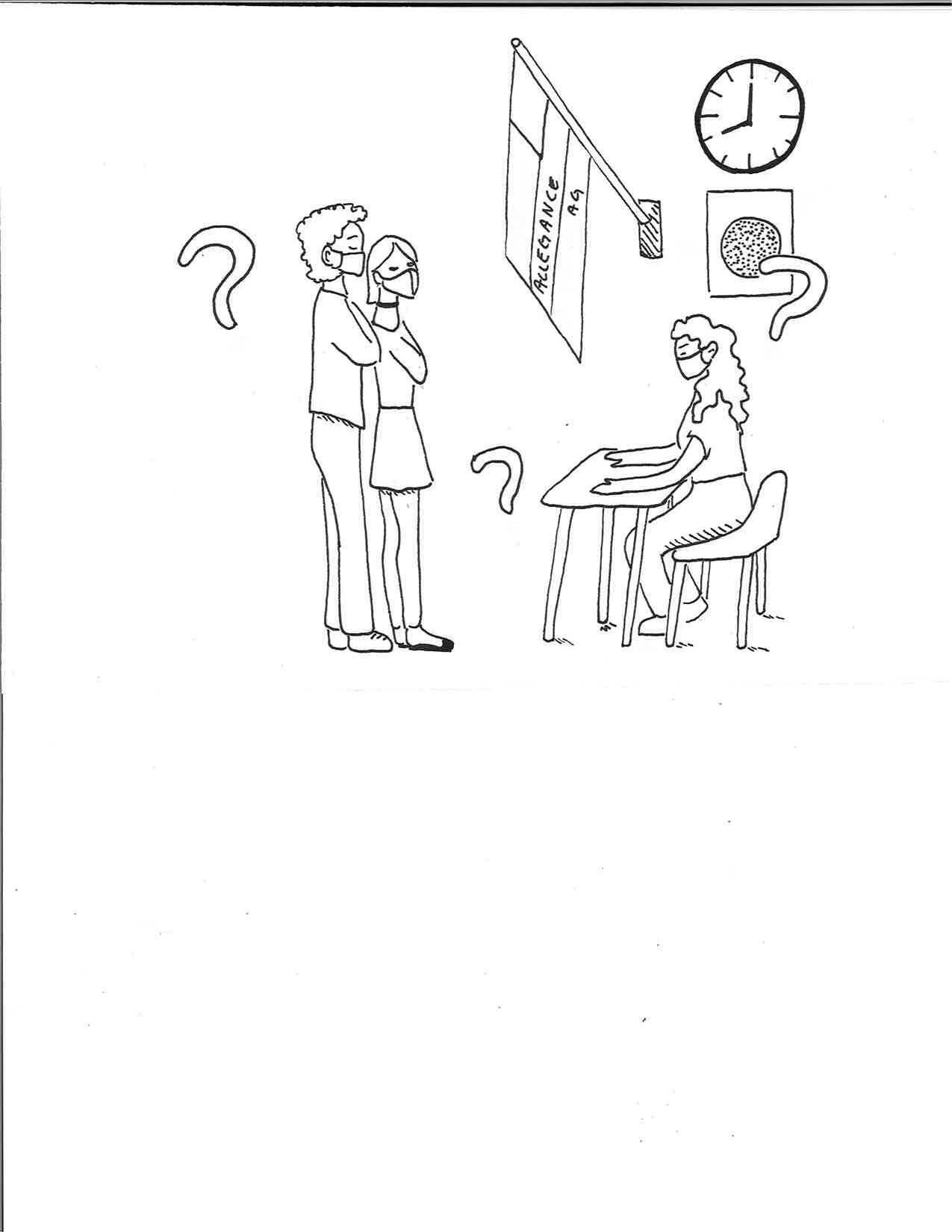
While it is more common now for people to choose to sit for the pledge if they want to, in 2019, Riley Brown, former Oyster River student who graduated in 2021, chose to sit for the pledge even when it was not commonly done. In an article Brown wrote in 2019 for Mouth of the River, titled: “Now Please Stand for the Pledge”, he discusses not only the opinions of students and Suzanne Filli pone, former principal, but also his own opinion on the issue. Brown touches on many different aspects on why he does not stand for the pledge, but also the hope that one day he would stand for the pledge. He says in his article, “Don’t get me wrong, I don’t have anything against the United States. I just hope to see a change large enough to make me want to pledge allegiance to my country every morning, and I don’t think that change has happened yet.”
To see what current students had to say, the range of argu ments had to be addressed. A poll was run on my personal Instagram account for the students of Oyster River to get their opinion. In the poll asking students whether they make the personal choice to stand, 71% of students (108 people) responded yes, they chose to stand, and 29% (44 people) responded no, they chose not to stand. Students also have the choice to follow up on the answer they chose in the poll, diving into a wider range of background on the option they selected.
Most of the students who believed that the pledge should be stood for explained that people should be grateful for the state of our country and where we live. Audrey Sigmon (‘23) goes into detail saying, “we are fortunate to be living in a stable country. There still are some problems but like it or not, people need to realize the luck we have to live here.”
Grace Keslar (‘23) agrees with this. She says she stands for the pledge “to show respect for my country and everyone who’s giv ing something for this country.” People who stand for the pledge want to show respect to the country and the good done. Howev er, this can range for many people.
Many people believe as well that we do not see liberty and jus tice for all. Alessia Garafalo (‘22) talks about her experience with not standing for the pledge saying, “I feel like standing for it [the pledge] means you support this country and everything it does and I don’t.”

To some, the idea of a unison pledge also feels somewhat cultish. Katherine McEwan (‘23) says that the way we go about standing for the pledge “reminds me of photos we see of kids during the Nazi regime saluting Hitler.” A dark twist on a national school “tradition.”
The pledge as well is not only used in schools, it is also used when receiving a green card in the United States. Oyster River has a diverse range of students who have not lived in the United States for their whole lives, and as such, have different outlooks on what a pledge to a country that may not have always been their home means to them. Dalva Cheney (‘23) is originally from Mexico. She expresses feeling odd standing for the pledge saying, “I did not grow up in the U.S., so I do not feel the need to [stand for the pledge].”
However, another student who also did not grow up in the United States, Rachel Rowley (‘22) sees this differently. Rowley has lived in the United Kingdom, the Philippines, and Australia before her family moved to New Hampshire. She stands for the pledge because she is grateful for living in the US. She says, “[it’s] a privilege I’m grateful for. In a way, I stand to represent my vow to always respect America and my work to help this country prosper.”
With standing for the pledge, many students feel as if they can’t express how they feel by standing or not because of fear of judgment. Rather than people doing what they actually believe in and others accepting that’s their individual opinion, people do something that does not make them happy to prevent upsetting others. Holden Bell (‘23) does not think standing for the pledge is for him, but does not want to face what people say. He goes into detail saying, “To be honest I wouldn’t [stand for the pledge] but it’s not worth all the people looking at you weird.”
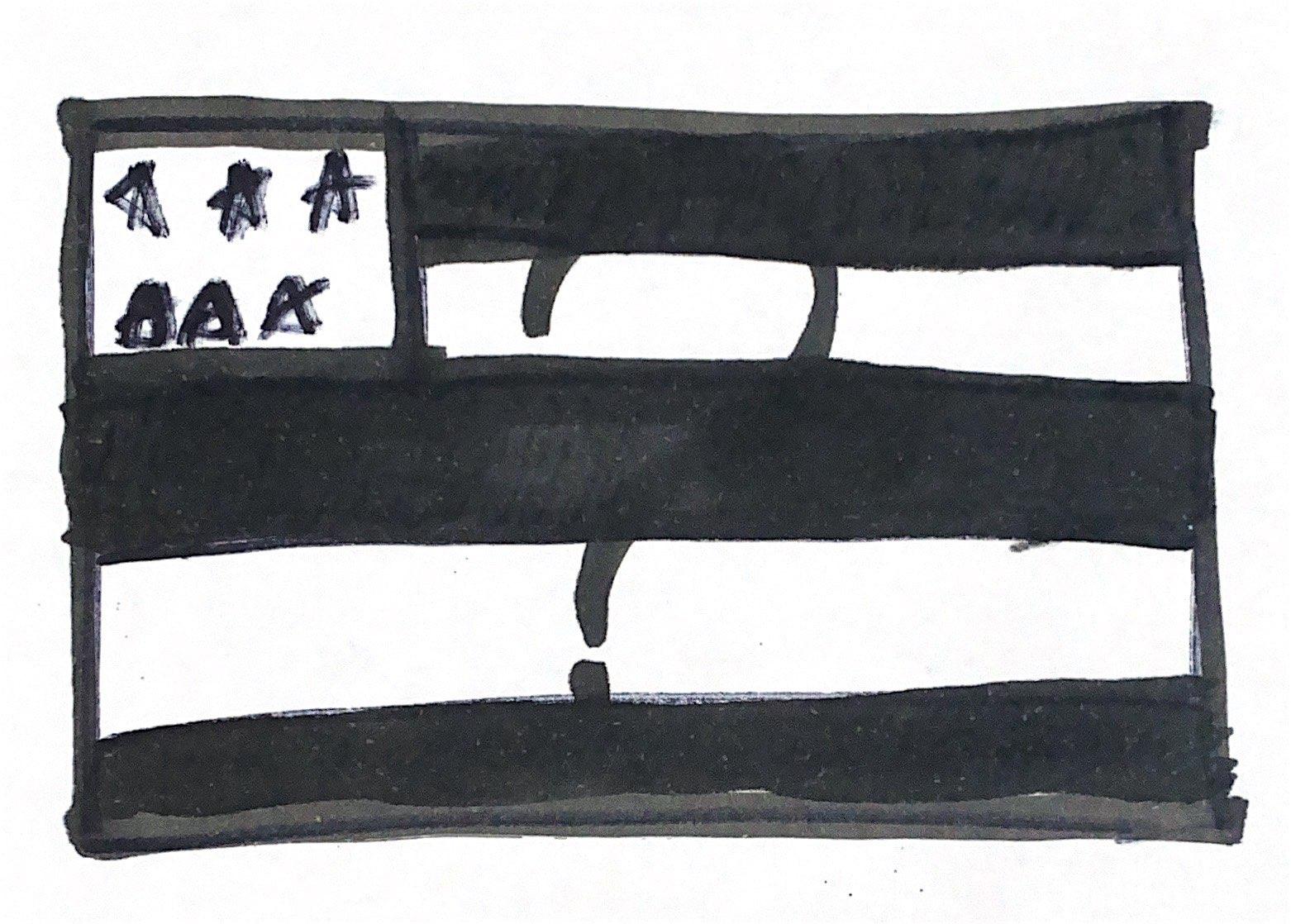
While it feels like this year has been the major turning point for people sitting for the pledge, this has actually been a growing trend that teachers have caught on to. Matthew Pappas, a Social Studies teacher, has noticed the growing trend of people sitting for the pledge started to rise in popularity about two years ago. He goes into detail as well, talking about why we even have a pledge. He says the pledge started in schools, “during the Cold War, probably in the 1950s, just to make sure that patriotism was alive and well.”
When making the choice to sit or stand, students do it with intent. Some believe that the pledge should be removed from the morning routine of our school, that the outdated words and the meaning no longer have relevance in our society. Seeing the pledge go however would upset lots of students who wish to respect their country. As of right now, making an intense choice on what to do would upset either group, meaning all that can be done is watching how this country changes as well as the personal beliefs of others.
“I stand to represent my vow to always respect America and my work to help this country prosper.”
The Senior Core
The last time the class of 2022 was in the building was back when they were only sophomores. Now, they have returned, only this time as seniors. As well as being back in, some senior tradi tions have been upheld, and some have not.
Each senior class goes into their year with high expectations of fulfilling the senior traditions- the biggest one being using the senior core. To many, the senior core is a place where their last high school memories are made. Students utilize it during their free periods, lunch times, before and after school to bond with their classmates, and to have a place in the school seniors can call their own. This year, administrators deemed the senior core as not COVID-friendly since it’s considered a place of gathering. While the senior class respects this decision, many students feel it is pre venting them from having the senior year they have been looking forward to since their first day at ORHS.
When asked about not being able to use the senior core this year, Sophia Isaak (‘22) said, “having this be our last year of high school, I think it’s just sad for a lot of people because they want to have the full experience.” Many seniors returned to school hoping for a normal year. The senior core was something seniors were expecting to spend time in.
Sam Haskell (‘22) expanded and said that the senior core is “something we all have been waiting for since freshman year and it being taken away from us was sad.” Haskell continued to explain how the loss of the core is affecting the class. “I think we all know each other, but didn’t get to see one another for a while because of COVID-19. The senior core could have offered a better chance to socialize with not only our good friends, but [also] the people we don’t usually see outside of school.”
Haskell continued to explain why seniors should be allowed to use the core. “I think we should most definitely be able to use the core and I think, as a whole, the core is a great place to socialize and get work done together if you need help from other students.”
He continued, “the senior core is a huge part of the senior experi ence and without it, the year feels incomplete.”
Isaak expanded on this and said, “just this week [during spirit week], people have been going in there, which is not allowed, but I feel like it has made us all closer. We have all been signing the wall and stuff and it just feels more like we are actually seniors.” She continued, “at the beginning of the year, I didn’t actually feel like a senior because we didn’t have a lot of the things seniors would usually have.”
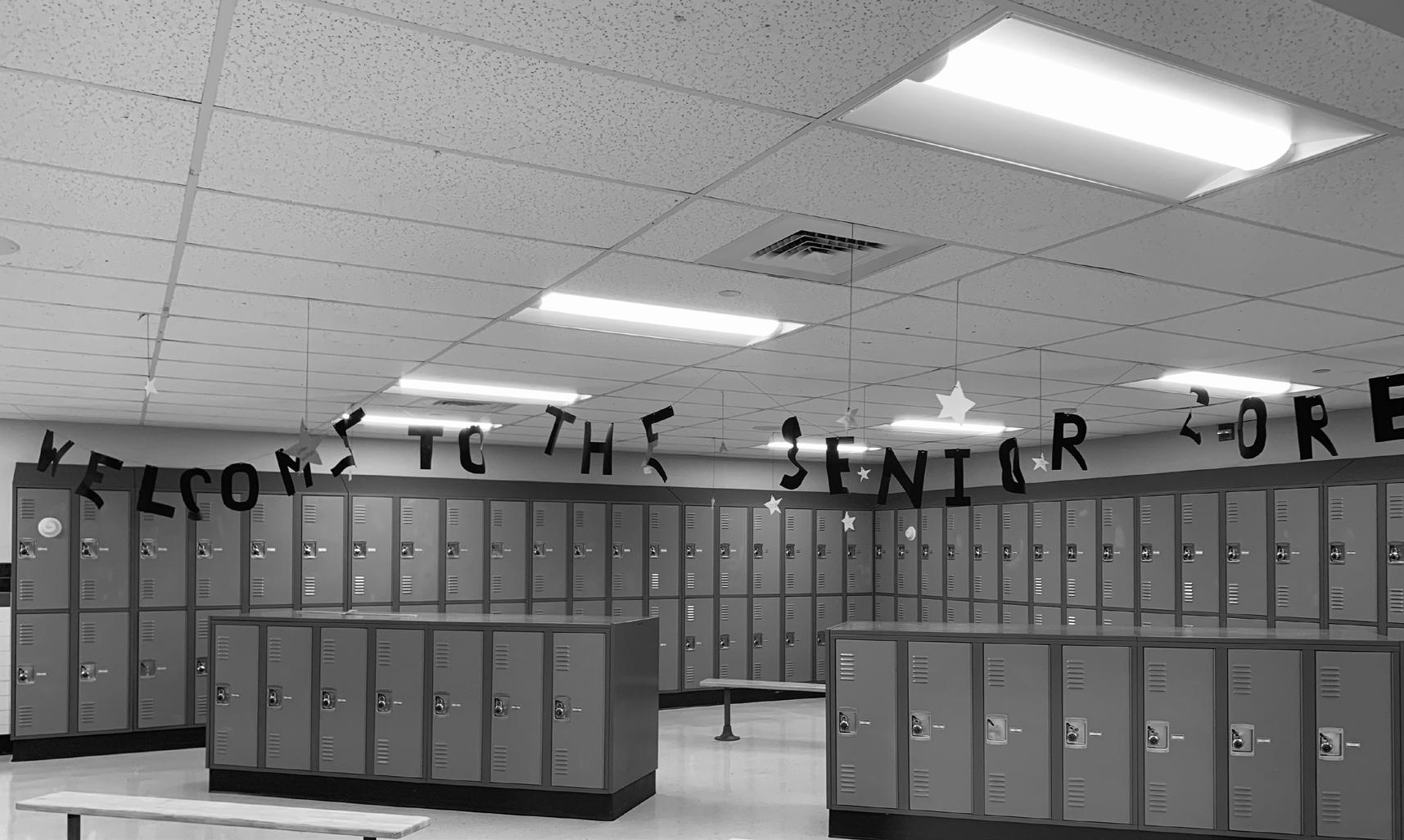
Class President KK Kalinowki (‘22) explained that she under stands the administration’s concerns. She said, “it’s totally under standable that we can’t go in there right now due to COVID-19 regulations and it’s not something that any faculty member is at fault for. It’s just the situation we’re in. Their job is to keep us safe before anything else and I’m glad they take that seriously.”
However, Kalinowski also understands how important the core is to the senior class. She said, “I think it’s making a lot of students frustrated because it is a vital part of the senior culture. Especially since the junior core was literally destroyed, [the senior core is] a tradition that we’ve looked forward to for the past three years.” She continued, “I also think that because other classes don’t know much about [the senior core], I think some seniors are scared that it’s going to die out.”
Administration members acknowledge that keeping seniors out of the core is affecting the class. Michael McCann, the Dean of Students, said, “I know people are missing the core. I understand, but at least we are back in school and we are able to give people lockers [in the core].” He continued, “I’m sure there is still that sense of loss when you don’t get to do something that is a tradi tion and you’re looking forward to something and you don’t get it. I’m sure that bothers some people, especially because it’s not something you can just get back because after this year, you aren’t here.”
While students do understand the importance of following COVID-19 guidelines, many feel that these guidelines are only implemented at certain times. This makes them feel that it is unreasonable to call the senior core “not COVID friendly.” Isaak explained, “in class, for the most part, we are not sitting that far away from each other. We are all actually pretty close to each other. Same thing when you are walking through the hallways during the switch of the bell. We will all be crowded into the hallway and, yeah, we have masks on, but we are still super close.” She continued, “I feel like a few of us sitting in the senior core isn’t that big of a deal because people just go there during their free periods, so it’s not like the whole class is going to be in there all at once.”
Oyster River High School Principal, Rebecca Noe, ac knowledged that COVID-19 guidelines are not always followed during the school day. She said, “in some classrooms, it’s hard to do the three feet. There are some classrooms where you physically can’t do the three feet, like the computer room. There’s just 22 kids and you don’t have 22 computers three feet apart. So, issues like that have come up but the actual guideline says ‘whenever possible.’” She continued to explain that the core being closed off is to prevent avoidable group gatherings.
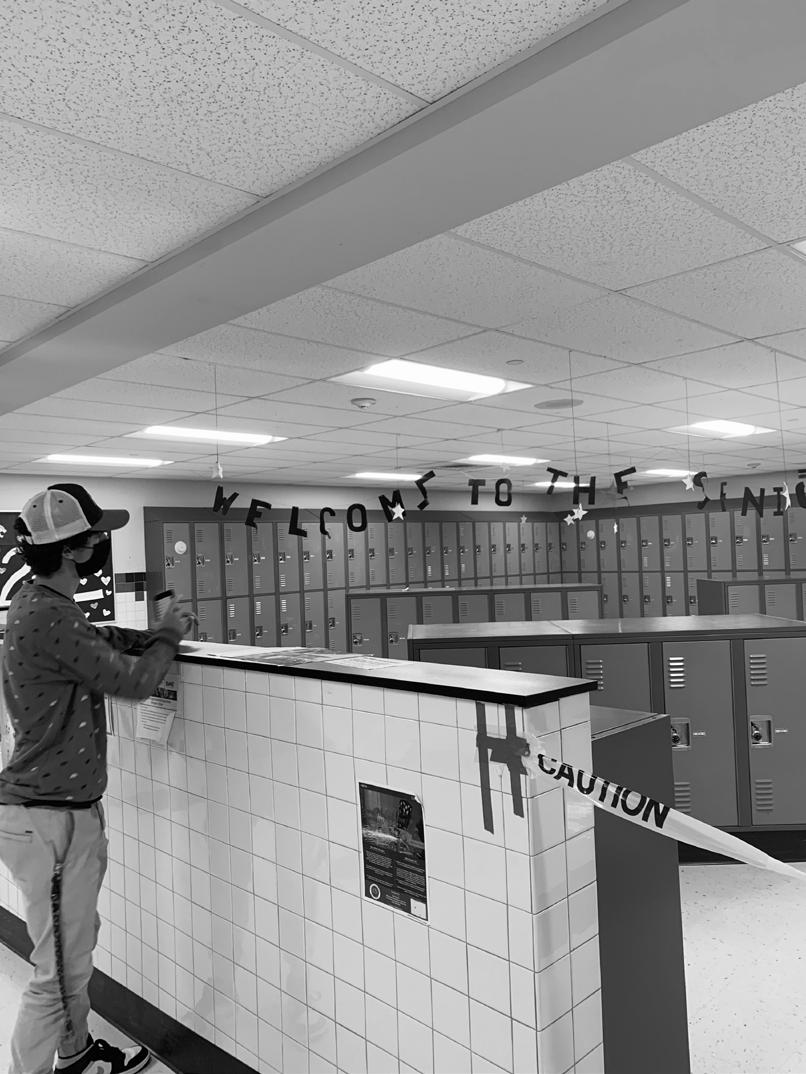
However, closing off the core is not something the administration wants to continue to do for the whole year. Their decision was a result of COVID-19 cases rising in the state, but also because students haven’t fully proven to be responsible when it comes to COVID-19 guidelines. Noe said, “part of [proving responsi ble] would honestly be when we have school events like Mr. Bobcat and the Hypnotist show [where] people stay where they are supposed to.”
Using the night of Mr. Bobcat as an example, she said, “we had to make an announcement to ask students to stop moving stickers. We put them so that [the seats] were three feet apart. We want people to be together, but we have to follow that [three-feet rule] as much as possible.” She continued to explain that she would use the pep rally day event as another test to see how well students would follow the COVID-19 guidelines. “I think what happens here [at the pep rally] is going to tell me a lot about how seniors can handle having the core open.”
Now that the pep rally has occurred, Noe followed up on this. She said, “I don’t want to say [the seniors] failed [to follow COVID-19 guidelines] at the pep rally. I would say we need more practice [at following COVID-19 guidelines]. We aren’t competent yet. It wasn’t everybody [who wasn’t wearing masks]... my observation was that it was the same three core groups of kids that kept taking them off, but they were kind of big groups. They would not leave [the masks] on.” Howev er, she continued. “There is still an opportunity [to open the
core again] but I don’t see it happening before the end of first semester.”
McCann continued on this, saying, “it’s natural for people to gather and get together and it’s a problem that happens outside too. When you’re outside, it’s just not the same kind of issue… it isn’t so much about seniors proving [to be] respon sible, but rather the nature of [wanting to gather] as well.”
He continued to explain when specifically the core could be opened again. “If we are in the green and we don’t need masks, then I don’t see why we wouldn’t be able to open [the core] up. I don’t want to be skeptical, but I don’t know if that’s gonna happen anytime soon given the trends and cases around the state.”
However, Isaak believes that if the senior core was open, many would be more careful and willing to follow the COVID-19 guidelines. “If we wear masks, I just don’t see the issue… there’s also teachers around there all the time, so if they really cared, they can check to make sure [we are all three feet apart]. I’m also sure everyone would wear their masks and stuff if we actually got to sit there.”
Annika Kell (‘22) expanded on this. “I feel like students would bring their own lawn chairs and with those it is easy to sit three feet apart if we are given the chance to use the core. I think seniors would know enough to follow that rule and self-regulate.” She continued, “I feel like our administration should at least give us a chance to prove that we can be trusted with this and if it ends up not working out, they can always take it away. I am confi dent that our seniors are able to follow the rules.”
Administrators understand that seniors are upset about losing the core so they wanted to do something extra for the senior class. They decided to have a pizza party before the pep rally on the turf spe cifically for the seniors. Kalinowski said, “the pizza party for seniors was also pretty epic and I think a lot of seniors enjoyed having that time reserved just for them to eat and socialize.”
Many are also still grateful for the events they have had this year. Kalinowski said, “all of the COVID-19 regulations rob us of a lot of opportunities to get close as a class, but we’re really thankful that we could have as much [of a] spirit week as we did. It’s one of the most integral parts of school spirit… our senior run was something [that] I mentioned was super important to seniors and I’m glad we were able to have it.”
As for the future of the core, Noe and other administrators have said that it is unlikely to be opened by the end of the se mester. However, if COVID-19 cases begin to decline sooner than expected, the senior core may be opened.

Student Housing Plan in Mill Plaza ~ An Overview

Throughout downtown Durham, many lawns have had black signs with phrases like “Demand a Community Friendly Plaza Plan.” But what exactly are they in opposition to, and how is it affecting the residents of Durham?

Colonial Durham Associates, or CDA, owns the plaza that is home to a Hannaford supermarket and other businesses in downtown Durham. They want to build two new large, separate buildings on the 10-acre site. The development would consist of one three-story building and one four-story building, each a mixed use of office, commercial, and residential space for students and it has caused quite a controversy. Signs have popped up this summer all over the Durham area as the plan started to gain more attention from residents.
Rick Taintor, the contract planner on the Planning Board for the town of Durham, has been working on this specific project for around 4 years. “There has been so much discussion of this project…at this point, I think there are competing interests. The developer wants to have a project that is a scale that they can get a financial return on. The neighbors would like to have a lower scale, lower density project.” This means that the developer just wants a project that they can make money off of, but the neighbors want a smaller project that won’t disrupt their town or spill over into their neighborhood.
Taintor explains, “the developer and owner of the plaza, Colo nial Durham Associates, wants to expand the plaza and add two buildings, replacing one of the buildings in the plaza now. The buildings would be a mix of student housing with a limited amount of commercial space on the lower levels.” The plans call for 258 student beds in primarily four-bed room apartments in the two buildings, and 411 parking spaces. Sean McCauley, the developer for this plan says “Our desire is that when you come to Mill Plaza you don’t come just to go to the grocery store and leave, you come to visit as many of the tenants as possible and spend time at the plaza.”
The Planning Board plans for the future of Durham by working with members of the community to help to create a better town. Before the Planning Board meeting in August, the site plan did not provide a 75-foot buffer to College Brook, and would not have “a positive economic, fiscal, public safety, environmental, aesthetic, and social impact on the town,” per the Conditional Use zoning. The Planning Board has had multiple meetings on this topic, and in August they gave the green light to the developer to proceed with their revised plan where the parking spaces were pulled out of the buffer of College Brook. It is said to provide more open space and less impact on the environment. As of right now the project is a public hearing.
One of the main concerns for this plaza being built is the fact that they would be violating the wetland setbacks and a December 2015 legal Agreement, destroying a 1.1 acre of wooded hillside in
the plaza. Joshua Meyrowitz, a professor at UNH and a resident of the neighborhood affected, has been following this plan closely. He explains, “both plans [Mill Plaza and Church Hill] are subject to, theoretically, strict Conditional-Use zoning, which should pre vent all the things these plans would add: the forbidden additional noise, traffic, light, hours of activity, mass/scale, etc. far beyond what the neighborhood experiences now.”
Also in opposition, Kay Morgan, a retired ORHS teacher and resident of the neighborhood affected, states, “this is a good neighborhood to be in because of its proximity to the university. I’m not as worried about the impact on the property value, more on the quality of living.” She goes on to talk about how her main concerns are that noise and litter will find their way into the peaceful wooded areas around the neighborhood.
Those in opposition have been going to meetings regarding the Mill Plaza plan in hopes that the Town Council and Planning Board will not let this go through. From May to August of this year, those opposed created a petition that got over 1000 signa tures and was presented at the Au gust Planning Board meeting. The petition urged the Planning Board to deny the Mill Plaza plan applica tion because it violates their Zoning Ordinance, which was developed by the community to adhere to State regulations and reflect the values of the people. There has also been a lot of support from the residents of Durham by creating and putting up the signs on their lawns to try and sway the views of the Planning Board to make the plan more com munity-friendly.
McCauley has faced a lot of opposition from the residents but is still confident in his plan. “I envision something different. I think everyone will view this as a compromise. I think it’s a good plan, I think that once completed the plaza will generate significant revenue in property tax to the town, school district, and all the taxing authorities.”
There will be a meeting October 27 where the developers will come back to the Planning Board with more detailed plans on that concept. They will be going through the whole plan set again and asking for a vote for the Planning Board. “If it gets to the point where the Planning Board is comfortable moving ahead with this plan… on the 27th, they will likely ask me to draw up the draft decision and it will include a number of conditions and the findings, and so forth,” explains Taintor.
No matter what happens at the next meeting, the Planning Board vote isn’t the final answer. There is still much more to come. The next step for those in opposition could be “anything from a challenge in court if there is a good reason, to having to live with a massive project that a good number of Durham residents don’t want,” says Morgan.
- Caitrin FerrisUnderstaffed & Under Pressure
She said that it would be a 50 minute wait. Five-zero. After 15 minutes he walked back up, arms crossed, and said, “where’s my damn table?” She calmly explained the miscommunication and apologized for the confusion. With every word she said, his face got redder and the smoke started pouring out of his ears as he yelled: “‘You’re an incompetent child! You do not get to call me a liar! I will never be coming to this establishment again!’”
This interaction happened to Kim Gowell (‘22) at Olive Garden, where she works as a hostess and to-go specialist. Unfortunately, Gowell is not alone. Many staff members in the restaurant indus try have faced the same anger and hostility from customers. Most restaurants are understaffed and back to full-capacity after having limited seating throughout the COVID-19 pandemic, including many in the Oyster River community. They don’t have the staff needed to effortlessly operate and many customers have no patience. With even the most minor inconvenience, a customer will often choose to take out their anger on the person serving them without realizing the consequences it may have.
Over the summer, many local restaurants relied on high school and college students. With the start of the school year, many students had sports or other activities meaning they could not work the same number of shifts they had been. This left restaurants very short-staffed and struggling. This lack of staff means that everything takes longer and customers need to be more patient, which has become an issue.
Steve Newick, owner of Newick’s Lobster House in Dover, said that “most of the cus tomers are still fantastic, but what’s happened is there’s just more that are outright rude than there has been in the past and they’re more hostile. We’ve had people yelling and swearing at us, we’ve had someone throw food, just really unac ceptable behavior.”
The man who yelled at Gowell chose to react aggressively to something that she had no control over. That put her in an uncom fortable position. After the interaction took place, Gowell said, “I lit erally went back to our little break room and just cried for a minute.”
Kim Clark owns Clark’s American Bistro and Ciao Trattoria in downtown Durham. At her restaurant there haven’t been incidents as severe as Gowell’s, but there have been rude customers. Clark said that what she has experienced is “just passive aggressive. I had a customer say to me that I needed to do a better job training my staff.” When people act this way Clark wants people to think, “‘what would it be like in your own kitchen, if you were trying to cook seven dif ferent things, custom-made?’”
Some customers may choose not to have an outburst in a restau rant and instead write a review. Clark talked about how they have experienced negative reviews on online platforms like Yelp. She said, “[customers] will go off and write a review, rather than letting us have a moment to address [their concerns].”

The COVID-19 pandemic has been hard for everyone. With the rise of online ordering, most people expect their food to be ready the second that they arrive, even if they are dining in. Clark said, “I think that people who go out to eat should look at it as an experience, and if you’re in a hurry, go to McDonalds. If you want to sit down and be waited on and have an experience, you’ve got to give the people working there the opportunity to give you the experience.”
Ariana Jackson (‘23) works at Ciao Trattoria where she is a hostess and makes pizzas. She said, “if I don’t have a pizza ready at the exact time [the customer] comes in, they are pretty passive aggressive and are asking ‘why is it not done yet?’ Then I have to explain that I’m making pizzas for other people too and there’s only two ovens.”

Gowell said, “I just dont think it’s necessary to be mean for no reason. I understand that you’re frustrated but that’s not our fault. People getting mad at you for it feels [terrible] because then you feel responsible, when you’re not.”
Both Clark’s American Bistro and Newick’s have taken matters into their own hands by putting up signs requesting that customers remember to be patient and kind. Newick said, “the treatment by the guests has improved since we put up signs and [started to escort] people out if they cause a scene.”
Part of the statement Newick’s sign said was “‘if you feel the need to rant and rave, like a spoiled child, please ask for me, Steve Newick (I’m here most of the hours we’re open). Newick’s crew members do not deserve the abuse. I will listen politely. Then, I will ask you not so politely to leave and never come back. It may not be the best thing for business, but we have taken too much abuse over the last year and a half and I will not subject our crew members to more.” Although Newick originally thought releasing the statement could be bad for business, he said the statement went viral and actually caused a sharp increase in customers as well as a better work environment for staff.
For many restaurants, staff have been stepping up to help each other out. At Clark’s American Bistro, Clark noted a time when she saw this: “I walked in [to the restaurant] and there was Jess, our food and beverage manager, making pancakes. It’s kind of [the] roll up your sleeves and ‘what do we all need to do to get this done’ [attitudes] that have been positive.” She also said that at both of her restaurants, “we have really good managers, and we as owners try to be there during busy times too. [Our staff] see us going to speak to a customer and it helps reiterate the fact that we’re going to have their back.”
The COVID-19 pandemic has hit the restaurant world hard. Restaurants, like those in the Oyster River community, have been surviving and trying to make the best out of a bad situation. Looking to the future, Jackson said, “I just hope that [customers] will become more understanding. We’re all human beings and everybody makes mistakes once in a while. It’s just not fair [to harass] someone who is working for you.”
- Libby Davidson ArtworkbyMaryJeongWelcome John Willemse and Allison Plourde
As Oyster River transitions into a new school year, they welcome two talented new art teachers: John Willemse and Alli son Plourde. The Oyster River community misses former art teachers Tim Lawrence and Tracy Bilynsky, but is also excited to meet and work with new teachers. So far, students have given positive feedback about the new art teachers. They have noticed a well rounded skill set from the art department, and unique art experience and energy from the individual artists. The new teachers are transitioning well to a new change, especially considering there are only new Oyster River teachers in the art department as Maria Rosi is away on maternity leave. Willemse and Plourde have loved meeting people and already have big goals for the art department.
Willemse currently teaches Intro to Art, Drawing and Painting I, and Digital Photography. He is excited to be a part of the Oyster River school district and work with students. Willesme says he decided to work at ORHS because, “I liked the art teachers [Lawrence, Rosi, and Bilynsky]. Before I knew them, though, I just saw the school culture as very diverse, inclusive, and accepting of all different ideas… That, in itself, I thought would form a great art department and great art curriculum with room to explore,” he said.
Willemse enjoys connecting with each individual student and watching them grow. It took Willemse some time to fig ure out what he wanted to do for a career, as he went back and forth between multiple interests and career choices in college. Willemse explains that his favorite part of teaching is “seeing somebody start at one level and then all of a sudden [grow]. It doesn’t always happen in a thorough evolution. Sometimes you just see [growth] one day and not another. All of a sudden they have a skill, or interest that they didn’t have before. It’s like watching life form itself, which I thought was interesting and I liked the creative process.”
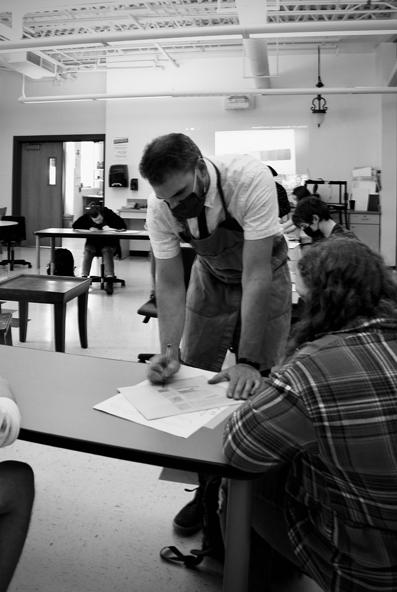
Before Willemse realized he loved teaching art, he pursued another love of his: playing music. Willemse plays guitar, sings, and writes his own music. Picking between music and art was a tough choice for him at the beginning of college. Willemse got a music business degree at the Westchester Con servatory of Music in New York, but eventually decided he didn’t want that to be his main career. Later, he got more seri ous about creating art and got an associates degree in graphic design at SUNY Rockland Community College. He continued with that education and got a Bachelor of Science degree in Visual Art Education from State University of New York at New Paltz. After college, Willemse spent time dairy farming and got some teaching experience as a substitute teacher for art and as a teacher aid.
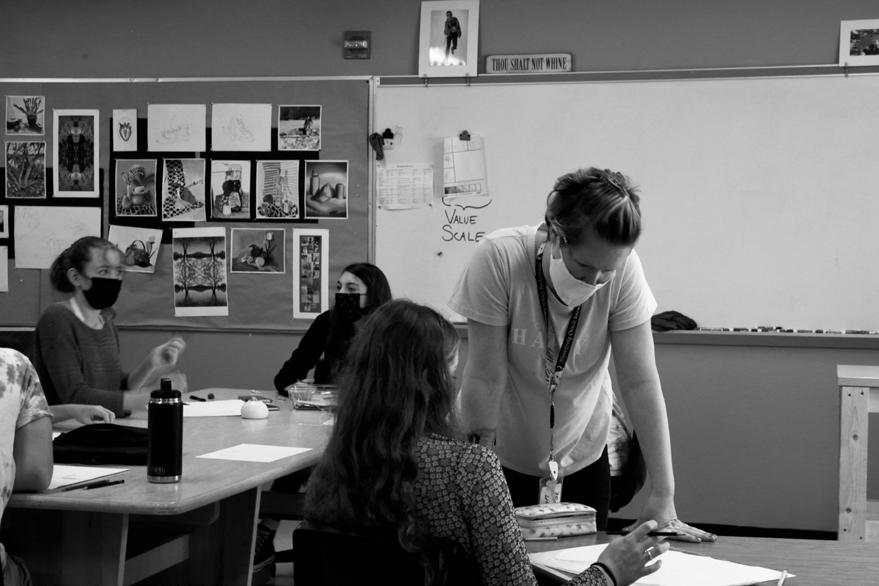

Now that Willemse has settled into a teaching position at Oyster River, he gets to work with a wide range of students with different interests. He is excited to help guide different students through the process of learning different skills, expressing ideas, and discovering new interests. He says, “I think the biggest take-away that I try for every student is to have a different perspective from when they came in.” Willemse continues, saying he wants his students to “under stand something through seeing it and interpreting it and then expressing it. It’s important because it’s their funda mentals of art.”
Elise Riddel (‘22), a heavily involved art student, first met Willemse was during his interview process. From the start, she saw great technical skills in figure drawing. After working with him a little more this year, she has noticed more qualities like how much effort he’s willing to put in to
keep and expand the inclusive art community.
Gavin Smith (‘25) enjoys Willemse’s teaching in Introduction to Art. Smith says he has improved a lot in his drawing, and also thinks the lessons are fun. Although transitioning into a new school and community can be difficult, Smith thinks that Wil lemse is transitioning very smoothly. Smith describes Willemse’s classroom environment as “a mix of energy and productivity.”
Willemse agrees that his transition to a new district is going well, especially considering everyone currently working in the department is new. He explains, “we are all new, so I’m not mod eling myself after someone who has it down perfectly. We are all just learning and relearning. I’m in the same boat as everyone in the department right now. Once [Rosi] gets back, I can’t wait to be a part [of a program] with someone professional who has been [teaching for] about 15 years. I think I’ll learn some mistakes I was making while on my training wheels here while learning the whole department.” Although getting to know everyone has been a challenge, this has also been a highlight of teaching for Mr. Wil lemse. He’s excited to continue this process and make some art.
Plourde teaches Advanced Art, Senior Studio, and Pottery I and II, and has been working with art for a long time. She started college with a minor in art at the University of New Hampshire, amd then transferred to Rochester Insti tute of Technol ogy school for American crafts to get her bach elors in Ceramic Sculpture and Pottery. After that, she decided she wanted to become a teach er, so she went to the Rhode Island School of Design to get her Mas ters of Teaching. Now Plourde has twelve years of teaching behind her, starting with two years in northern New Hampshire, two more in Colorado, eight years at private New Hampshire schools, and now here.
Plourde explains that she loves teaching because “being with students, inspiring students, and having students working around me is also very inspiring for me as an artist. I love being able to be in a school where the arts are very respected and thought about. I think the art department is going to thrive because of that.” Plourde was interested in coming to ORHS because she was instantly impressed with people’s talent and focus in art. She adds, “I love how kind everybody is. Everyone wanted to get in the class and create art, love the culture of the open space, and collaborate and be welcoming.”
Plourde believes art is a great and important way to express ideas and oneself. In her classes, she tries to help students com municate ideas. “I want them to feel like they have their own

voice and to express that through different mediums. I want to be someone that can just provide them the materials and some constructive criticism for their vision and their voice. I feel like in this day and age right now there’s a lot of us that have something to say. I just want to help them to be able to do that and to find the best way to do that visually.”
Aspiring art school student Ella Daniels (‘22) is currently tak ing Plourde’s advanced art class, and says that she definitely sees this value come into play in Plourde’s teaching. “It’s definitely a new energy. I think that she brings a lot of new skills and a whole different mindset and viewpoints that I never really thought about before. So it will be interesting to see how the rest of the year goes and how she handles a bunch of new students. She’s doing pretty good so far.”
Even though transitioning into a new community is difficult, Plourde is excited for the opportunities Oyster River offers. She has several goals for the art department, including “organizing this space so that we can utilize it a little more effectively and provide what we need to for all sorts of students trying to get to different levels in their art career. I would love to be able to offer an Advanced 3-D Sculpture [class] if [it’s] wanted.” Plourde’s biggest goal is to collaborate with the other art teachers to create a welcoming space for everybody that will help artists grow.
Daniels and Riddel describe the art room as a home, produc tive space, and inclusive place to work. It’s also an important space for many students to gain skills, have a creative outlet, and express themselves. It’s important for the art community to be continued and grown, which is why the district is lucky to have hired teach ers with similar mindsets to the previous ones.
In the hiring process, Mark Milliken, the dean of students, was looking for teachers who could make a good team, bring different skills, and connect well with students. Milliken explains how from the beginning, the Willemse and Plourde “came into the art room with kids and created a lesson and taught a lesson. The thing we liked about both of them was how kid-centered they were in how they really wanted to connect with our students and get to know their students. If you think about it, it’s an awkward situation. A new school, new kids you’ve never had and you have these adults watching you. They did very well, they were comfortable, they were creative, they were friendly and engaging with our kids and the kids really liked them.”
Riddel and Daniels are looking forward to having their new art teachers connect with them and other students. Daniels says, “I want them to be able to share their own experiences and thoughts on doing things, because I know I’m getting ready for college and having a different viewpoint and suggestions on my own profile would be helpful for college.”
The art teachers are excited to teach and share their love of art, as well as learn from their students, at Oyster River. Plourde and Willemse are still meeting people, organizing, and getting com fortable. As they do this, the two teachers are getting better and transforming the art scene. Art potential is booming in the art rooms, so look out for new material coming out of the art room, and pop in to say hello to Plourde and Willemse!
- Hannah Muessig Art by John Willemse and Allison Plourde
Let’s Get Thrifty
Whether you’re searching to find the perfect vintage leather jacket or simply looking for ways to spice up your wardrobe, thrifting is definitely the way to go, and Durham is the place to do it. An affordable, fun, and envi ronmentally conscious way to shop, thrift ing has gained lots of popular ity, especially within the past few years through Tiktok and Instagram. Granny Chic Boutique and Topan ga Canyon Vintage are two secondhand clothing shops downtown that are helping to develop the thrifting scene in Durham. With strong beliefs about the value of thrifting, yet vastly different clothing styles, both stores hope to provide a place to shop for unique clothing pieces while also hoping to create new opportunities for the com munity. Gran ny Chic is located in the space previously occupied by the Main Street Mak ery. The owner, Elizabeth Catalena, originally opened in Contoocook, NH last February, but moved the store to Durham earlier this summer. Her store

provides a variety of clothing, accessories, and homemade gifts, and she takes inspiration from many different parts of fashion history, whether it be the Victorian era, styles from the 60s and 70s, or simply something cool she saw a person wearing out in the street. In general, Catalena wants her store to be an ode to old styles and aesthetics as if you were to walk into your grand mother’s closet.
Curating the collection takes a while, but Catalena’s process al lows her to find pieces of the highest quality for the store. Rather than going to chain thrift stores like Savers or Goodwill, Catalena will visit people’s homes and rifle through their old boxes of clothes to pull two or three pieces. “I look for quality, and I want natural fibers, but I also try to find things that I can rescue, things that normally would end up in a landfill somewhere,” says Catalena. “I’d rather bring them in, res cue them, do some mending on them, and put them out for sale.”

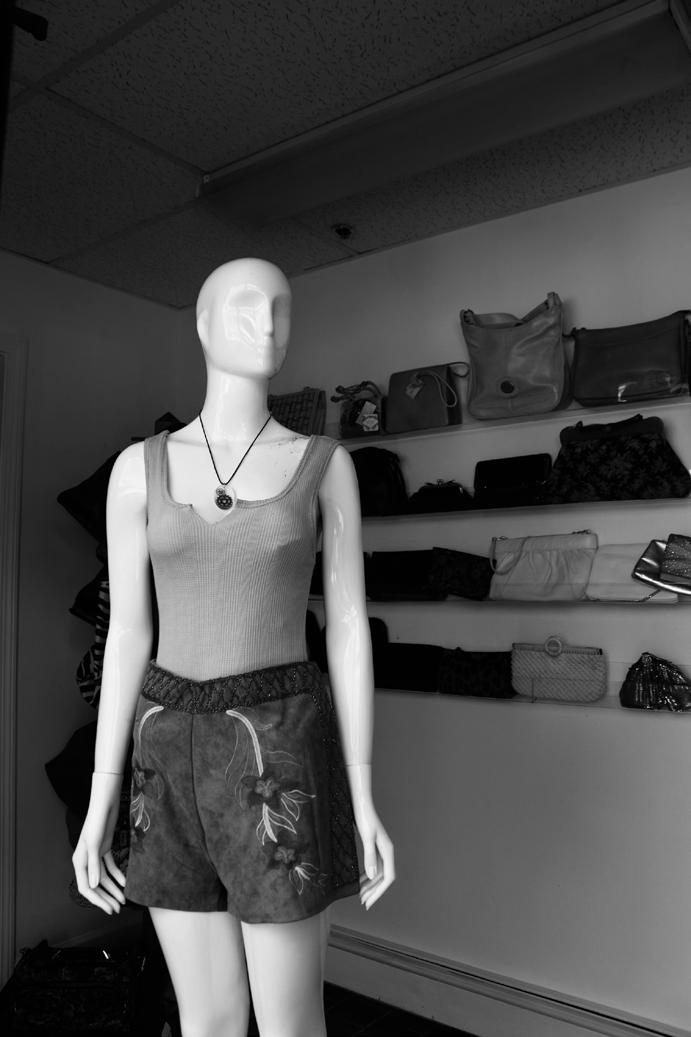
Saving and reusing pieces is at the heart of the store, and Catalena hopes that her shoppers will embrace a similar mindset. “I like to see people shopping the past instead of buying in the present. There’s very little need to buy new, especial ly clothing, and everything is already out there. Just go and find it. It’s an adventure,” says Catalena.
As someone who has always loved to create things, Catalena also hopes to expand the store soon for her “maker space.” This area in the store will be used to teach sewing classes and the pro cess of upcycling, which is when an old piece of clothing is made into something completely new. Catalena loves taking things from the past and forming them into modern designs, so many pieces in the store are things she has upcycled herself. She hopes the “maker space” will allow others to learn how to create and reuse some of their own clothes.
Just across the street on Jenkins Court is another thrift store:
Topanga Canyon Vintage, which first opened shop last spring. This store is all about encapsulating the diverse, lively, and free-spirited atmosphere of Topanga Canyon, California, which is situated between San Fernando Valley and Malibu. “I grew up in California and we had places for people who sort of had an alternative lifestyle, like punk or metal,” says Joan Brown*, the man ager of Topanga Canyon Vintage. “We basically went to stores and we could get together and have discussions and make our own clothes, and so I’m trying to bring that spirit into this space here.”
The pieces in the store are inspired by the lifestyles of these Californians as well as their passion for art and music, and the collection changes fast as the manager spends multiple days a week searching for new and unique items to bring in. Topanga Canyon aims to offer low prices too, in order to be accessible to as many people as possible. However, this does mean a shopper may miss out on finding an expensive, vintage piece. “If you’re looking for a perfect 1950s prom dress for $300, this isn’t your store, but if you want an $18 one that’s been converted into something else or patched-up a little bit, we are your place,” says Brown.
Topanga Canyon Vintage is also focused on combating several issues found within the fast fashion industry, especially the social impact. “We want to make sure that everyone feels included when they come into the space because we’re all different sizes, and it doesn’t matter what your gender is, we just want you to leave with something you’re comfort able in,” says Project Man ager, Jahmilha Crook.
Crook also noted the
store’s beliefs in making positive environmental impacts. She assures that all items have been previously owned or recycled to offset pollutants created by clothing production and to prevent over-consumption.


Clio Grondahl (‘23), another student who enjoys thrift shop ping, says that this is one of the main reasons she thrifts at stores like Topanga Canyon Vintage. “I’m taking Environ mental History right now, and I’m learning about this huge detriment that fast fashion can have on the environment. So thrift stores reusing these pieces is really helpful to stop all the excess from being sent somewhere to be burned,” explains Grondahl.
Although it may seem like just another Gen-Z trend, the thrifting scene is still continuing to develop within the commu
Canyon Vintage has a variety of purses, tote bags, and clutches to choose from

nity. Not only will shopping at both Granny Chic and Topanga Canyon Vintage help to support local businesses, but it will also further promote the ideas of sustainable fashion and buying clothes second-hand.
“Trends do go away after a while, but I’m hoping that this becomes an ingrained part of our culture so that we reuse a lot more of what we have and minimize waste,” says Grondahl.
- Lauren Hoppler
“I like to see people shopping the past instead of buy ing in the present. There’s very little need to buy new, especially clothing, and everything is already out there. Just go and find it. It’s an adventure.”Topanga T-shirts, shoes and other items sold at Topanga Canyon Vintage
What’s Cookin’ ORHS
Garofalo enjoys making frittelle because it’s a big food in Italian culture, and it brings her and her cousins closer to her grandfather. “I remember when I would go visit my Nonno when I was younger. One of the first things he would say to me was that he was making frittelle,” says Garofalo. “When my cousin and I were in Florida to visit him last year, he was so excited to teach my cousin how to make them. It was so adorable.”
The family recipe may look simple at first glance, but Garo falo says the small details that go into cooking the frittelle are what make it special. For example, although some families let the dough sit for only half an hour, Garofalo warns that the shorter the amount of time the dough sits, the denser it gets. For this rea son, her family likes to let the dough sit for a few hours to make it as light and fluffy as possible.
I’ve always loved the idea of family recipes. Every year, my family comes together to make our version of Choreg, an Armenian Easter bread. My sisters, cousins, and I are the ones in charge of preparing the dough for the oven. Using Easter-themed cookie cutters or braiding it in a traditional way, we’ll shape the dough before giving it an egg wash, sprinkling it with sesame seeds, and popping it into the oven. To be honest, I don’t like the bread that much, but I love the idea of making something Armenian and spending time with my family.
I was curious to see if other Oyster River students had similar experiences with their families and whether they had any unique dishes to share. Lo and behold, multiple students have family recipes that they not only find delicious, but that allow them to connect with their family and their heritage.
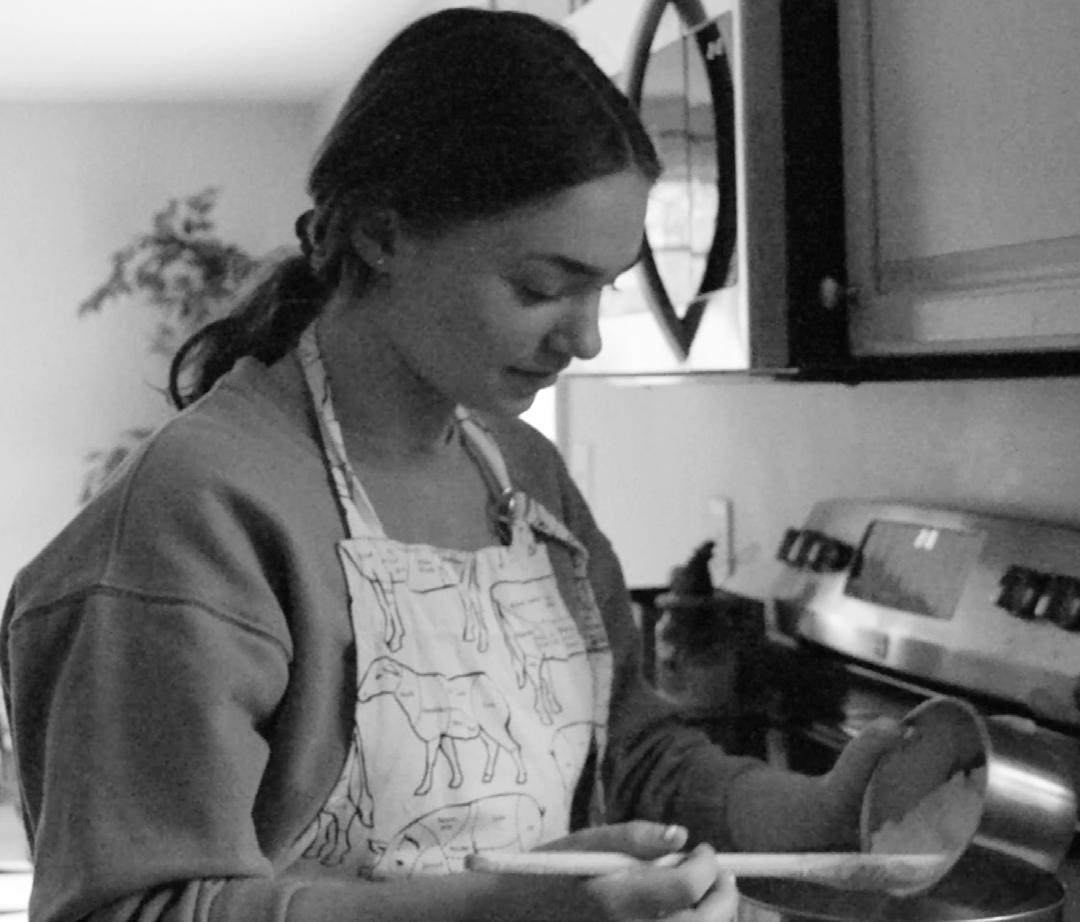
Alessia Garofalo’s (‘22) family makes plenty of Italian dishes, but one of her favorites is frittelle. Frittelle is a simple but savory fried dough served with ham and cheese that Garofalo describes as an “elevated panini.” It is a very casual dish, often eaten at home at gatherings with friends and family or sold at small street carts found in Italy. Although Garofalo first learned how to make Frit telle from her father, the family recipe comes from her grandfa ther.
Another nuance within the family’s frittelle recipe is the water temperature. “The main thing with Italian cooking is that there are no exact measurements. In this recipe, the water temperature is supposed to be about 112 degrees, and to test that you dip your finger in the water. If it feels too hot then it won’t be right for the dough. It’s supposed to be a little bit warmer than lukewarm,” says Garofalo.
Garofalo also likes how Frittelle is the perfect example of how Italian dishes can vary across Italy. “Fritelle from the region that my Nonno is from is very different from where it would be in Northern Italy. And where I’m from, they would be served sweet and savory, but it is more often than not sweet,” she explains.
In Ethan Yu’s (‘22) family, seaweed soup is a staple. This dish is a traditional Korean soup consisting of seaweed, beef, soy sauce, garlic, and salt. Seaweed soup is very common in Korea. Although it is mainly eaten on someone’s birthday, it can also be eaten as an everyday meal.
The recipe itself may seem basic, but Yu says that it’s easily customiz able, and that different ingredients can be added to personal ize the soup. The Yu family will either add rice to their soup for extra flavor, or on the side, they will have kimchi. Kimchi is salted or fermented vegetables like cabbage that adds an element of spice to the meal.
Yu’s mom is the one in charge when it comes to making the seaweed soup. Every year, she will make the recipe for each mem ber of the family on their birthday. Although Yu has never helped his mom prepare the meal, he loves eating it and how it brings back fond memories of childhood birthdays. “Ever since I was a child, I’ve had it. I’ve grown up with it and it tastes good, so I get
“Korean food is what connects me to my Korean culture. Growing up in America, I feel like I kind of missed out on that, so this is something I can hold on to”
Passed down from generations and cooked to perfection, the recipes of three ORHS students from different backrounds are bound to make your mouth water
happy when [my mom] makes it,” says Yu.
Yu also emphasizes the importance of dishes like seaweed soup in his life. “Korean food is what connects me to my Korean culture. Growing up in America, I feel like I kind of missed out on that, so this is something I can hold on to,” says Yu.
Although seaweed soup may seem unappealing to some, Yu encourages people to try it if they get the chance. “You have to try it before you judge it. Seaweed soup is better than it seems,” Yu says.

Chinese chicken curry takes the cake as Sofia Sarsoza’s (‘22) favorite family recipe. Served over rice, the dish is a blend of ten der chicken thighs, savory curry sauce, and rich spices. The dish has become very common in China and around the world, which Sarsoza attributes to its rich flavors and varying textures.
The family’s Chinese chicken curry recipe originates from Sarsoza’s great grandma. The recipe was then taught to her grand ma, her grandma’s brother, and finally her mother. Although the recipe has been passed down, Sarsoza’s family struggles to recreate it exactly how her grandma makes it. “We still haven’t mastered it. It’s kind of sad because it’s one of our favorite dishes, but maybe one day we’ll be able to replicate it perfectly,” says Sarsoza.
When Sarsoza does get the rare chance to have her grandma’s curry, she loves it, especially considering how much the dish helps maintain her connection with her grandma and with China. “[The dish] has helped me connect to my Chinese heritage, mainly
Fritelle
Ingredients:
- 1 cup hot water
- ½ tablespoon yeast
- 1-1 ¾ cup of flour
Directions:
1. Stir together hot water and yeast together 2. Add flour and mix together with a spoon 3. Take mixture in hands to form with dough and cover with a damp towel for a few hours 4. Roll pieces of dough into little balls and flatten them out like pancakes
5. Fill a pan with oil (enough to cover the bottom of the pan) and fry each piece until the edge is golden brown

when my grandma comes to visit. She loves to cook and she’s always asking my brother and I what we want her to make that night. It’s either the curry, fried rice, or this fish dish with corn, but the curry is my absolute favorite,” says Sarsozsa. “She’s starting to develop Alzheimer’s too, but the curry is something she always remembers how to make, and that’s really cool to see.”
Overall, the Sarsoza family enjoys Chinese chicken curry because of its rich flavors that they don’t get to taste very often. “What I like about it is the taste and the flavors. The combination is something that all of us really enjoy about the meal, and it’s especially important to us because of how few times we actually get to eat it. That helps keep the magic of it,” Sarsoza says.
As someone who loves the idea of family recipes, I decided to recreate each recipe myself. Check out the video on MOR’s you tube channel to see my attempts and find each recipe down below (including my own family recipe) to expand your own culinary horizons!
Seaweed Soup
Ingredients:
- Beef (Sirloin Steak)
- Oil
- 5 cups of water (boiled)
- Soy sauce
- 1 tablespoon of garlic (minced)
- Seaweed
- A little bit of Salt
Directions:
1. Cut beef into pieces and stir with oil. 2. Add soy sauce next, then minced garlic and stir more. 3. Boil water and then add seaweed. 4. Keep boiling for 3 minutes. 5. Add salt
Chinese Chicken Curry
Ingredients
6 pieces boneless chicken thighs
4 big red potatoes
1 small red onion
1 pc of scallion
1 tablespoon of curry powder
1 can of coconut milk
1 teaspoon of chopped ginger
Pinch of salt
Pinch of pepper
1 tablespoon of soy sauce
1 teaspoon of cornstarch
Pinch of sugar
2 bay leaves
Water
Directions
1. Cut chicken into small pieces (2”)

2. Season Chicken with salt, pepper, soy sauce, sugar and cornstarch
3. Chop ginger, onions, scallion
4. Put 1 tablespoon of vegetable or coconut oil in pot - when it’s hot add ingredients on step 3
5. Saute until it’s brown then add seasoned chicken
6. Brown the chicken
7. After it’s brown add curry powder and potatoes
8. Finally add coconut milk. Use coconut milk can after it’s emp ty and add ½ can of water to dilute the coconut milk

9. Simmer until chicken is ready (about 15 minutes)
Choreg
Ingredients:
1 cup whole milk
1 cup unsalted butter
1 cup margarine
1 cup white sugar
½ cup of lukewarm water
2 teaspoons white sugar
2 packets of dry yeast
6 eggs
6 cups flour

1 ½ teaspoons baking powder
1 ½ tablespoons mahlab
1 ½ teaspoons salt
1 tablespoon sesame seeds
Directions:
1. In a saucepan combine milk, butter, and margarine. Heat until butter and margarine are melted. Stir in 1 cup of sugar then set aside to cool to lukewarm.
2. Mix 2 teaspoons of sugar in warm water. Sprinkle the yeast over the surface and let it stand until frothy.
3. Crack 5 eggs and break up yolks. Slowly pour in heated milk mixture and continue whisking. Add yeast mixture and stir until blended.
4. Combine flour, baking powder, mahlab, and salt. Make a well in the center and pour in the wet mixture. Stir until dough forms.
Then, need for about 10 minutes and place in an oiled boil to rise for about 2 hours.
5. Once the dough had doubled, punch down again and let it rise until it doubles again.
6. Preheat the oven to 350 degrees and roll out the dough. Cut dough into desired shapes then brush with a beaten egg and sprin kle with sesame seeds.
7. Bake with love for 25 minutes!
- Lauren HopplerWhat Popping with the Principal?
A woman who started college in Florida to become a vet erinarian, an avid runner, and now a school administrator, Principal Noe is an exciting addition to the school community. Now, it’s time for everyone to get in the know, or rather, the “Noe,” about Oyster River High school’s new principal.
After former principal Su zanne Filippone was promoted as the district’s assistant super intendent, Oyster River High School needed a new principal. The process to hire one consist ed of multiple interviews, hefty applications, and a school visit. With such a comprehensive process, it was important for candidates to have answers that stood out, and Noe was cer tainly up to the challenge. The hiring team felt that Noe has the right outlook on education, and that she shared district values of what’s important for their students to grow and learn.
ORHS school counselor Heather Machanoff was on the hiring team, and absolutely believes Noe had great things to say. “Her answers to the questions were obviously quality an swers for the first round…[From] her interactions with the fac ulty that I observed, [I] could tell she would be able to facilitate meetings, speak to the larger faculty, and have conversations with teachers that would be helpful,” says Machanoff.
Coming into a new school, Noe does not want to change Oyster River to be an exact replica of her formal school. In stead, she accepts the new environment and the challenges that come with it. This means listening to the staff and students on what Oyster River as a whole does to succeed. Michael Mc Cann, the Dean of Students at ORHS, sees this, saying, “every leader has a different personality and approach... When you’re starting off in a new place, you listen and learn first and that’s part of the process for any school leader or district leader... that’s a lot of what she’s doing right now.”
Noe actively works on learning what the students want. With COVID-19 affecting events students look forward to ev ery year, including Spirit Week, Mr. Bobcat, and the Pep Rally, many feared that these time-honored traditions would be lost. Noe listened to the student body and ensured these traditions returned, even if new spins had to be put on them due to COVID. Along with the revival of old traditions, a Fall Festival was added to the end of spirit week. The festival was held the Friday after the pep rally and will hopefully be seen again in the coming years.
In addition to maintaining Oyster River traditions, Noe also brought over several traditions from Bedford. “Probably out of the two assistant principals at Bedford, I was the harder one… When COVID-19 started and we were pushed out, we thought it was going to be two weeks and all of a sudden it wasn’t two weeks, so I just started thinking about ‘how can we do something that will still make kids laugh?’’ This question birthed an account on Instagram with the username @bhsnoe, as well as a Tik Tok account under the username @ educatorsinquarantine. Noe says, “I knew they would never ever expect me to do some thing like that.”
She learned the art of making Tik Toks, her first one showing off her line dancing skills. Noe became so invested in the account that she creat ed a schedule of different Tik Toks for each day of the week. “I made Medal Monday, so if somebody did something good in the community I put it on my Instagram so they got recog nized for it. Tik Tok Tuesday, Where is it Wednesday. I’d take something in the school and they’d have to guess where it was, Throwback Thursday, so pictures of past pep rallies or football games or things we had done together… and Themed Fridays.”
Now that she’s at Oyster River, Noe has created a new Instagram account: @orhs_noe. On this account, Noe features pictures from events that staff and students participate in. This includes sports games, teacher workshops, and other day to day school occurences. In addition to this, Noe has also started a program called Bobcat of the Week. This program allows students and teachers to be celebrated for the good deeds they have done.

As Noe starts her career here at Oyster River, she plans to take the school on a positive track are clear. A big part of being a former teacher means she wants to help our staff greatly. She says, “if I can help more teachers, I’m actually helping more students… Getting teachers resources they need, looking ahead at their curriculum, and making sure they have whatever they need to implement what they want to do that helps [students].”
Oyster River is very lucky to have gained a member to their administration team who cares so much about students and teachers. With COVID making things hard for students, Noe is making sure that everyone being back in the building is a positive experience, and there is no doubt that she will contin ue to do so.
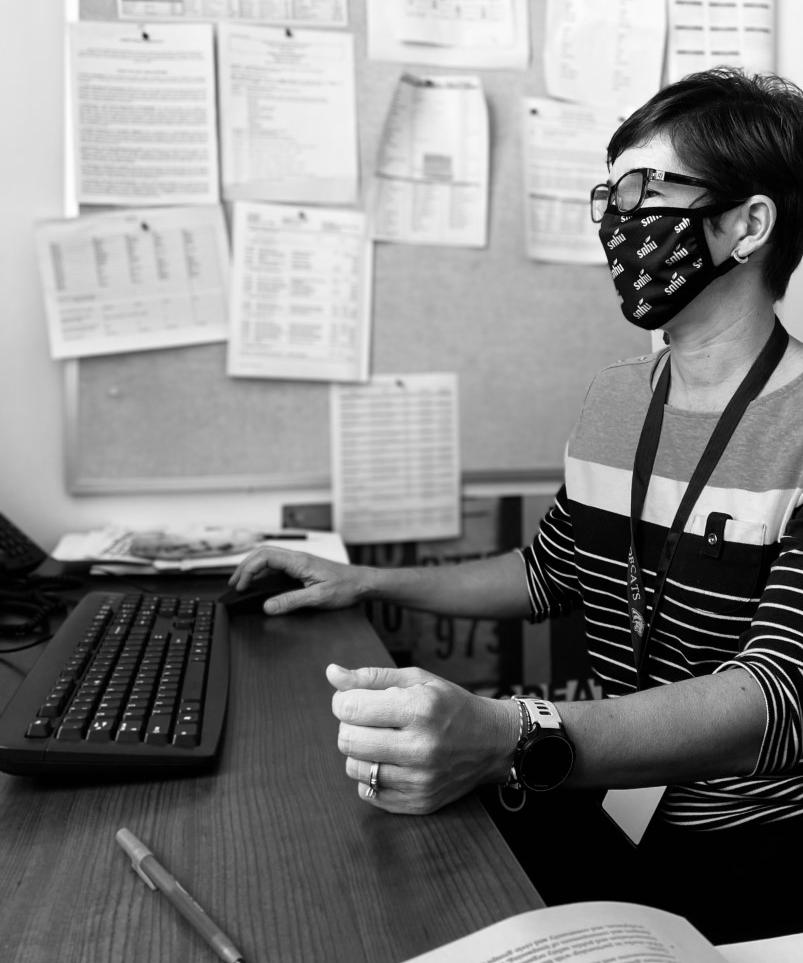
The Caffeine Controversy
Walking into a first period class, you are guaranteed to see a wide variety of Aroma Joes, Dunkin’ Donuts, and Starbucks coffee cups around the room. Depending on what you’ve read, the coffee drinkers in that classroom probably have stunted growth and are fueling their underlying issues with anxiety. Or maybe you think that iced latte is decreas ing their risk of certain cancers.
The ongoing debate of whether coffee is healthy or not extends past your mom’s nagging to cut back on coffee and into the field of science. The effects of coffee have been super-studied by scientists and nutrition experts, who have debunked long-standing myths and gained new knowledge about it. As the most common source of caf feine for Americans, many students and teachers use their morning coffee as an energy boost or as a means to stay up late working on homework. It’s not uncommon to hear students claiming that they should drink less coffee, but is that really true?
“The public sometimes thinks that coffee is bad, but research doesn’t really back that up. Most of the science out there shows that coffee consumption is actually helpful,” said Jesse Morrell, Nutrition Director at the Univer sity of New Hampshire. There are both benefits and drawbacks to caffeine consumption, but Mor that the positive effects of drinking coffee (in moderation) include mental and physical health improvements.
Jennifer Weeks, a teacher at ORHS, said that her morn ing cup of coffee allows her to comfortably wake up earlier and to feel mentally alert. This is one of the more common reasons that people choose to drink coffee.
Kimberly Wolph, a nurse at ORHS, said that these effects are from the caffeine in coffee. “Caffeine gives a person energy due to it being a stimulant and therefore increases brain activity as well as [releases] adrenaline within the body,” she said. This stimulation allows coffee drinkers to feel more awake throughout the day.
Not only can drinking coffee improve your mental state, but it also claims to have many physical benefits as well. “Metabolically, you have better insulin resistance [and] it helps with liver function… It [also] reduces liver cancer rates,” said Morrell. According to the article “9 Reasons Why (The Right Amount of) Coffee Is Good for You” by Johns Hopkins Medicine, drinking coffee can also help to improve physical performance, decrease the likelihood of developing type 2 diabetes, and
lower the risk of death by strokes, heart disease, and kidney disease.
The article claimed that drinking coffee can protect con sumers from developing Parkinson’s Disease, Alzheimer’s Disease, and Dementia, all neurodegenerative conditions that have no known cure. “We see people who are coffee drinkers living longer,” said Morrell.
It’s worth noting that there is an obvious bias for claiming that coffee is healthy since large coffee businesses benefit from positive reports on it. We should be skeptical of some of the studies on coffee that are released because of the in fluence that these companies may have on the research that is being done.
Additionally, more coffee doesn’t neces sarily mean more health benefits. In general, Morrell suggests that people, especially high schoolers, should have less than 400 mg of caffeine (about four 8oz cups of coffee) per day. Doesn’t sound too hard, right? Keep in mind that a Dunkin’ Donuts large iced coffee contains an estimated 396 mg of caffeine. A venti cold brew coffee from Starbucks has about 310 mg of caffeine.


Just because 400 mg is the recommended caffeine limit for high school students, it doesn’t mean that it’s the perfect amount for you. “I have a really high caffeine tolerance, but there are times that, if I drink a lot in a really short period of time, I’ll feel jittery. Normally, I just focus a lot easier and I’m nowhere near as tired as I would be if I didn’t have a cup of coffee,” said Justin Partis (‘22).
Sofia Calzone (‘22) said that she has experienced similar effects from drinking a lot of coffee. “I’m probably the worst person to drink coffee because I already have a lot of energy. Sometimes I’m literally shaking in class,” she said. Wolph said that these uncomfortable physical feelings are due to the stimulating effects of caffeine. “Caffeine increases the activity within certain organs in the body. Too much caffeine (stimulant) can leave some people feeling nervous and jittery. They may also feel actual chest pain and an increase in heart rate,” she said.
With firsthand expe rience, Weeks agreed that drinking coffee has sometimes intensified her feelings of nervousness or anxiety. “[Coffee] definite ly doesn’t help with anxiety and if you’re already stressed out about something, then it stimulates that even more,” she said.
In addition to getting “the jitters” and feeling more anxious, coffee can contribute to migraines for
“We see people who are coffee drinkers living longer.”
those who are prone to them. Lilly Henderson (‘22) said, “if I don’t have [coffee] for a few days then I get migraines and headaches.”

Morrell provided her perspective on why this happens. “Consuming way too much caffeine or not enough could be a trigger for migraine-sufferers… when you really deviate, migraine-sufferers tend to have trouble,” she said. She emphasized the importance of consistency of coffee con sumption if you are sensitive to migraines.
One particularly creative rumor that makes some students believe that coffee is not a healthy choice relates to its effect on growth and development. “I’m sure it’s bad for me. My friends joke that it stunted my growth and that’s why I’m so short,” said Henderson. According to “Can Coffee Really Stunt Your Growth?” by Harvard Health Publishing, there is no “scientifically valid evidence to suggest that coffee can stunt a person’s growth.” They wrote that “most growth occurs well before most people are drinking coffee regularly. By the time we’re in our teens, most people have almost reached their full height.”
Many students are more careful about their coffee intake

withdrawal. The dopamine in caffeine stimulates your brain and leads to mental alertness, but regular consumption can “produce physical and psychological dependence.” By going “cold turkey” with coffee after creating a habit of drinking it every morning, your brain has to quickly adjust to the lack of caffeine. The report claims that this is what leads to withdrawal symptoms, includ ing “headache, fatigue, decreased energy/activeness, decreased alertness, drowsiness, depressed mood, difficulty concentrating, irritability, and feeling foggy/not clear headed.”
If you are really worried about the withdrawal symptoms and are uncomfortable with feeling dependent on a substance, Morrell has suggestions on how to deal with cutting coffee out of your diet in a com fortable way. “The best way to reduce those symptoms would be slowly backing down from coffee,” she said. By having a little less coffee each day, your body has time to adjust to less caffeine intake. Morrell said that any withdrawal symptoms will go away after a week to ten days.

Morrell brought up the importance of considering what you are consuming along with the coffee. “For coffee and
because of the concern about developing a dependence on it. Haley Pickering (‘23) said that she is trying to wean off of coffee because she has developed cravings for it. “I find that in my classes, if I don’t have caffeine in the morning [then] I can’t wait until I get some at lunch,” she said. If she doesn’t have her morning cup of coffee, it affects how she feels throughout the day. “I think that it kind of sets me off my balance for the day. It makes me a little distracted and I’m not in my [normal] mindset,” she said.
Partis decided to do “caffeine cleanse” over the summer to see how a sudden lack of caf feine would affect him. “I was working a lot and I found that I would be misplacing things or screwing things up that I would normally be fine with if I had a coffee in the morning,” he said. Accord ing to the NCBI scientific report “Caffeine Withdrawal” by Karima R. Sajadi-Er nazarova and others, these are symptoms of caffeine
energy drinks, we see people mix them with alcohol and other drugs [and] smoking. There are other behaviors that get tied in with caffeine consumption. That is probably the bigger concern,” she said. The caffeine in coffee can dilute the depressant effect of alcohol, cause increased memory impairment when mixed with marijuana, and increase the blood pressure of cigarette-smokers. By combining coffee with other variables, consumers take away from its health benefits.
Whether you consider coffee as healthy or not lies with your priorities. Nutritionally and medically, coffee has shown to have many benefits. Dependence on caffeine has been well-studied and has been concluded to be less of a concern for most people. Morrell said that the key to a healthy caffeine intake is balance and moderation, which is different for everybody. She said that even if you consume more than what is recommended, “we’re not seeing detri mental effects. Some people might feel a little more anxious or jittery, but we’re not seeing long-term health effects for most people.”
“I’m probably the worst person to drink coffee because I already have a lot of energy. Sometimes I’m literally shaking in class.”
- Laura Slama
Where In The World?
-Summer Travel-
After almost two years into the COVID-19 pandemic, people were finally able to do the one thing they missed the most: travel. As some one who was stuck in New Hampshire this summer, I enjoyed (but also was slightly jealous) seeing people’s social media posts of places they visited. Seeing the views, the food, the culture in the photos posted, I wanted to know more about people’s experience. I took it upon myself to talk to a couple of people about their trips so that other community members could get a sense of what place to visit.
This summer, Annika Kell (‘22) went to Greece. Kell has trav elled to many different countries including Iceland, Costa Rica, and Czech Republic before but she felt that this trip was different. She said, “travelling again was a very cool experience because it allowed us to get out and see the world again...it felt extra special this time.” During her time in Greece, Kell mostly visited beaches. “The water there was just so nice and warmer than the water here and much more clear… the beaches were overall just so much nicer than the beaches I get to experience here [in New Hampshire].”
Kell described each of the places she visited. In Athens, she said that “the environment was not touristy at all. It felt like an actual city and we were living with people who actually had homes there too which was a cool experience.”
“In Santorini, it was the most touristy place we went to. All the places were either restaurants or hotels,” said Kell. She continued, “but the vibes there were just so chill and everyone was relaxed…no one was in a rush to be anywhere.”

Santorini also happened to be Kell’s favorite part of the trip. “[Santorini] used to be a volcano but it exploded. So,half of it sank underwater but there is still land in the middle.” She continued, “we took a tour so we could hike up the volcano and after we got to the top we could see everything [the island]. It was really pretty.”
Right after hiking up the volcano, Kell took a tour in a boat around the island and she got the chance to jump off the boat and go swimming in different coasts.
Also in Santorini, Kell got to experience an amazing sunset. She said, “people always claim it’s the most beautiful sunset and it was absolutely gorgeous.”
Another highlight of Kell’s trip was the food in Greece. She said, “I loved the food… I don’t exactly like seafood that much, which is actually most of Greece’s main courses, so my whole family ended up eating a lot of appetizers.” She continued, “there was stuff like freshly-made hummus and pita, potatoes, cheese, bread, roasted tomatoes, and greek salad. It was just so good and all the food just tasted so fresh and flavorful.”

Lastly, Kell gave a recommendation to any future visitors of Greece. “We went to Corfu and it had the best beaches, a forest, and a lot of greenery. I really recommend going to Corfu and [my family and I] went parasailing there which was awesome too.” She contin ued, “definitely go cliff jumping in Corfu but also in a lot of other spots and beaches.”
Nadia Pavlik (‘22) also visited Europe but to the north in Iceland. Pavlik enjoyed her time there and said her favorite thing about the country was the landscape. “There were a lot of really cool volcanic rock formations and a lot of different land features than what you would see in the U.S.”


Pavlik described the environment and culture in Iceland. “It’s definitely not super populous and there’s actually no one living on the inside of the island. There’s only like one road that goes around the island that has towns and cities.” She continued, “there aren’t any big cities. It’s mostly just small towns, villages, and a lot of remote and isolated places.”
Because Icelandic towns are more isolated, Pavlik said that the people there “are probably a much tighter-knit community and more closer than they [are] like in the U.S.”
As for Pavlik’s living situation, she said there weren’t many touristy places so she and her family stayed in a lot of hostels as they roadtripped around the country. She said, “we stayed in small towns where there really weren’t many other people and definitely not a ton of tourists there.”
The food experience in Iceland wasn’t anything unusual, as Pavlik said she didn’t try many new foods. “[Iceland] has a lot of good seafood there, I’ve heard, but I don’t really eat seafood so I personally didn’t try any of that,” she said. However, she contin ued, “one of the places we went to had really good lamb chops which is another thing [Iceland] is known for because they have a lot of sheep and goats. They are known for having a lot of local lamb chops.”
Finally, Pavlik gave advice and tourist attraction ideas for anyone who is interested in visiting Iceland. “[I recommend] pretty much any of the land and natural features there. They have a ton of volcanoes and we were actually able to hike and see an active volcano. We got to see the lava which was really cool.” She continued, “you don’t even need to go that far from the airport to find really cool features like fields and hot springs like the blue lagoon.”
Although Charlotte Cousins (‘22) stayed in the Unit ed States, her trip to Yosemite was absolutely memorable. Her favorite part of the trip was how serene the nature was. She said, “no matter where I went, it was beautiful. Here in Durham, you kind of have to make the drive to go see the water or mountains, but there I was constantly surrounded by amazing things.”
During Cousins’ time in Yosemite, she stayed in the park. She said, “It was surreal to wake up each day and see some thing new but equally [as] large and beautiful.” Though it was easy to focus on the beauty of the landscape around her, Cousins explained how difficult it was to see how some parts of the environment were struggling. “It was really sad to see how dry the park was. California is in a huge drought and during the summer it was pretty bad. Some of the waterfalls were barely flowing and some areas were completely dried up.”
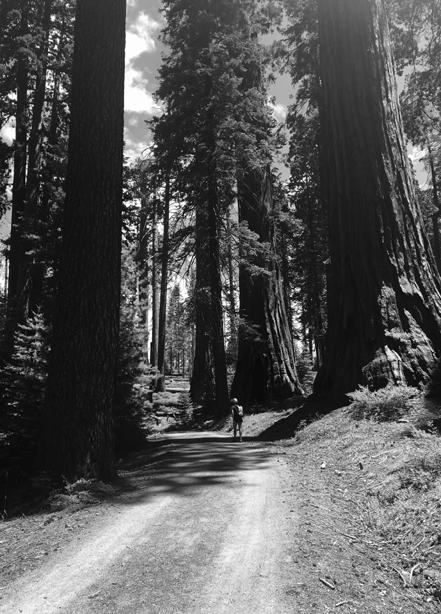
For any future visitors of Yosemite, Cousins gives her recommendations based on what she enjoyed most during her time there. She said, “there is really so much to do and it all depends on what you like; there’s so much variety.” She continued to explain the different rivers people can go swim ming in and how there are many places to get different foods to accommodate your tastes.
A couple highlights of her trip which she highly recom mended were the Yosemite Falls, Mono Lake, and going horseback riding. She said, “Yosemite Falls is the biggest waterfall in the park and it was honestly a little scary for me because I’m afraid of heights, but it’s sort of a must see.” She continued, “I was also a huge fan of Mono Lake which is a saltwater lake, so if you swim, you float.” However, her favor ite activity was horseback riding. She said, “riding through the mountains and woods felt like such a natural way to see things.”

Cousins hopes to be able to visit Yosemite again and said, “I definitely need to go back so I can do the Half- Dome hike which is 16 miles but so worth it.” Overall, Cousin’s described the experience as “so amazing and one of those ‘bucket list’ places.” She continued, “a solid 10/10 from me, although everything there is hella expensive.”
Avel Durant (‘22) was able to travel to two popular travel destinations this summer: Spain and France. His first stop was in Spain. “In Spain we went to Barcelona and we just kind of enjoyed the nightlife there. It was all good vibes and there were street performers at night which was really interesting.” He con tinued to explain that the people in Barcelona in general made the trip enjoyable and lively.


Another highlight of Durant’s trip was the Spanish food he tried. He said that the food was delicious and continued to ex plain his favorite dish. “I think it was tapas, which isn’t a specific dish but it’s a way of eating where you just order a bunch of dishes and that makes up your dinner.”

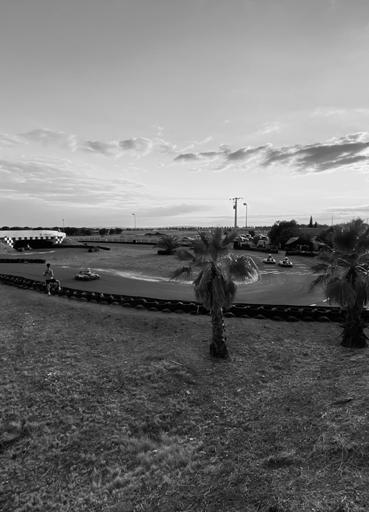

Durant highly recommends Barcelona as a future destination for anyone. He gives his recommendation to the future visitors: “Make sure you visit the center of the city and enjoy all the little shops that are there all around. The people who run the shops are from all around the world and the range of what they sell is so diverse. You can’t get bored of it. There’s everything from carpet shops to sports shops.” He continued to explain that they were all “open door” shops that people could just walk right in from the streets, making shopping convenient.
After Spain, Durant and his family went next door to France. He said, “In France, I was visiting my family. My dad’s side [of the family] lives there and I actually have some friends there too.”
Although Durant has visited France before, his favorite thing about the country remains the same. “The weather there [is my favorite thing] and we stay right outside of a city called Sete so we get a lot of nice weather. It is pretty much always sunny and the sunsets were great.”
Durant is also a huge fan of French cuisine and said, “French food is great…[my favorite] is probably teal which is a seafood pie.” Lastly, Durant gives his advice to people who are looking to visit France in the near future. “Try to know at least some [French] words otherwise [the people] won’t like you.”
Whether you’re looking to walk the sandy beaches of Santorini or climb the mountains of Yosemite, these ORHS students have the best recommendations for your next travel destination. I hope you got a sense of the culture, food, and the activities that you can do in each of these places and take them into consideration!
Scroll Through Sports
Sit down and scroll through Insta gram, and it won’t be hard to spot a post from one of the many new Oyster River High School sports accounts.
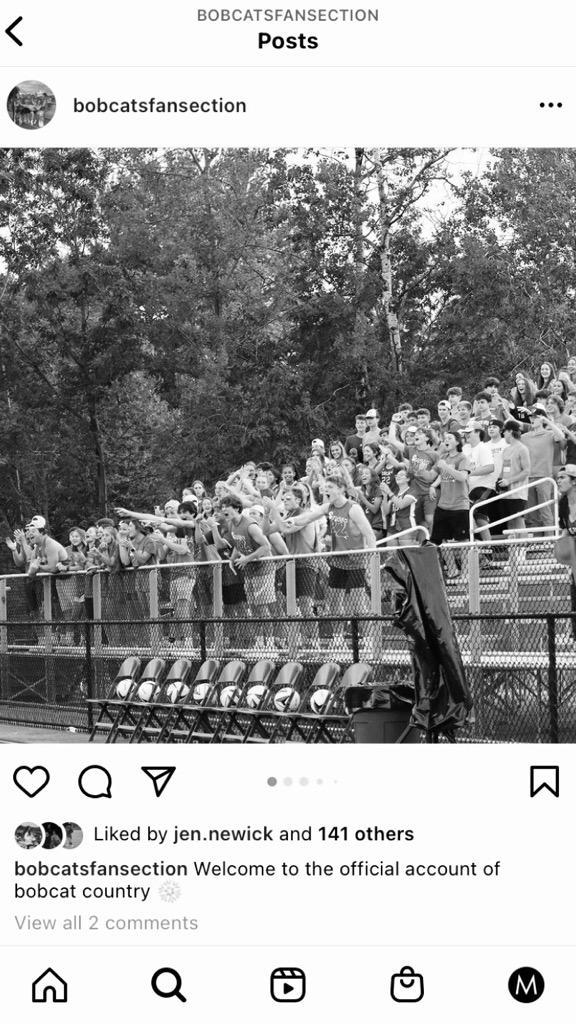

Getting back to school this fall has made a lot of things feel normal again, like sports and attending games. At Oyster River High School, students from every class fill the stands with su perfan shirts, energy, and loud cheers such as “Oyster River” or “we can’t hear you.” This fall, many ORHS athletes have created unofficial, student-led Insta gram accounts for their sports teams to have fun, get people hyped up for game days, spread word about successes and team processes through out the season, and promote team bonding through team spirit, fun games, and photo-ops.
The girls varsity soccer team made an account mid August called @themfsquad. A few girls stepped up and made the ac count for fun and started posting updates about their preseason. The first post on the girls account was a birthday post. This goes to show how relaxed these accounts are. It’s not just about the sea son and games, it’s about the bonding and team connections, as well.
Lizzy Robinson-Kiang (‘22) says, “we made the Instagram [page] as something fun. A lot of the other sports teams have Instagram pages and we knew it would be a good way to get people to interact with our team more. [We] share when we win, when we lose, it’s a good communicative space, especially for ourselves, [and] it’s really fun to be able to post things.”
The Instagram accounts have really made an impact on each
of the teams, as Robinson-Kiang mentions. “Since there are never any announce ments made about games, it’s a good way for us to share game day posts especially since so many people follow us now,” she says. Robin son-Kiang says that more fans are at games supporting their friends and bringing up the energy by cheer ing. The account has also added to team bonding and the girls just enjoying them selves. Brooke Thompson (‘22) says, “we do funny posts and stories, so it gets us excited as a team for games.” The team having happy and positive attitudes before games is both beneficial to their performance but also to their team chemistry.
The boys soccer team also made an instagram account this fall. The @orboyssoccer account notifies fans about games, what to wear, blue out, white out, pjs… and most importantly have fun together and share the success throughout the season. Nik O’Hern (‘23) says that “the account has generated some buzz for our team, as well as given our team a platform to express our personalities.” Many of the posts are funny and give you a vibe of what being on the team is like. The boys are always sharing positive posts and hyping each other up as they have team spags and competitive games.
The girls field hockey team @orfieldhockey created their account shortly after presea son ended. Ashley Harvey (‘22) explains, “it’s great [for] team bonding because everyone is involved and we can all post differ ent things. Especially fit-checks on our story includes
everyone
“We made the Instagram [page] as some thing fun. A lot of the other sports teams have Instagram pages and we knew it would be a good way to get people to interact with our team more. [We] share when we win, when we lose, it’s a good communicative space, especially for ourselves, [and] it’s really fun to be able to post things.”
and gets us all hyped up for the game.” The field hockey team has noticed that not only does the account build excitement for the group, but it also brings attention to the girls season. Annika Kell (‘22) says, “posting stories saying ‘game day’ has definite ly prompted people to come up to me and ask, ‘who are you playing?’, ‘are they good?’, and [also just] wishing us luck.” The extra support and congratulations is great for the girls as they move through a success ful season.
Harvey says, “I think that it has definitely made people aware of the season and our successes. I’ve had people come up to me the day after a game and say ‘good win,’ and it was mainly because they saw the instagram story [or] post.” Robinson-Ki ang shares a similar feeling. “It’s an easy way to let people know that we want the support at our games. We love when we have a fan section, it hypes us up and kinda makes us play better,” she says The Instagram accounts have brought more fans to games and the conversation of the games outside the field. This lets each team know that people care and are there to support them.

As everyone knows it’s been crazy for a while, so being able to attend games and build loud fan sections has pushed the school and community back to normalcy. The Instagram pages have a purpose to spread word about games and different events which leads to the normalcy and hype among teams and fans.
Other sports teams have had Instagram accounts in the past or have recently made ones after the increase in teams using the platform this fall. @bobcatsfansection, @orbobcatsgolf, @orgxc, @orhsalpineski, @or bobcatspuck, @orhsbob catsboyslax, @orhs.girls.lax, and @or.baseball are all accounts to keep an eye out for, as well as other accounts that may be created in the coming seasons.

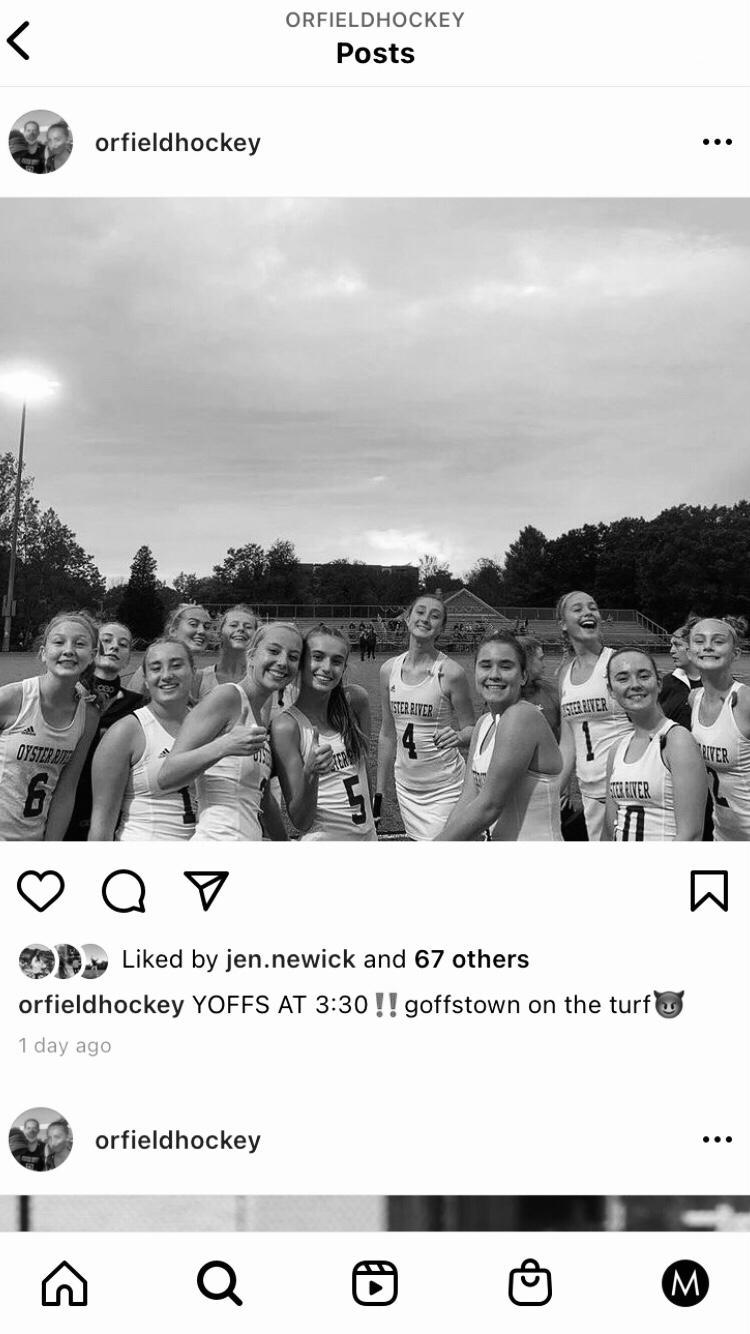
- Jen Newick
Photostakenfrom@bobcatsfansection,@orboys soccer,@orfieldhockey,and@themfsquadInstagram profiles.
“It’s great [for] team bonding because everyone is involved and we can all post different things. Especially fitchecks on our story includes everyone and gets us all hyped up for the game.”
Flirting With Your Future
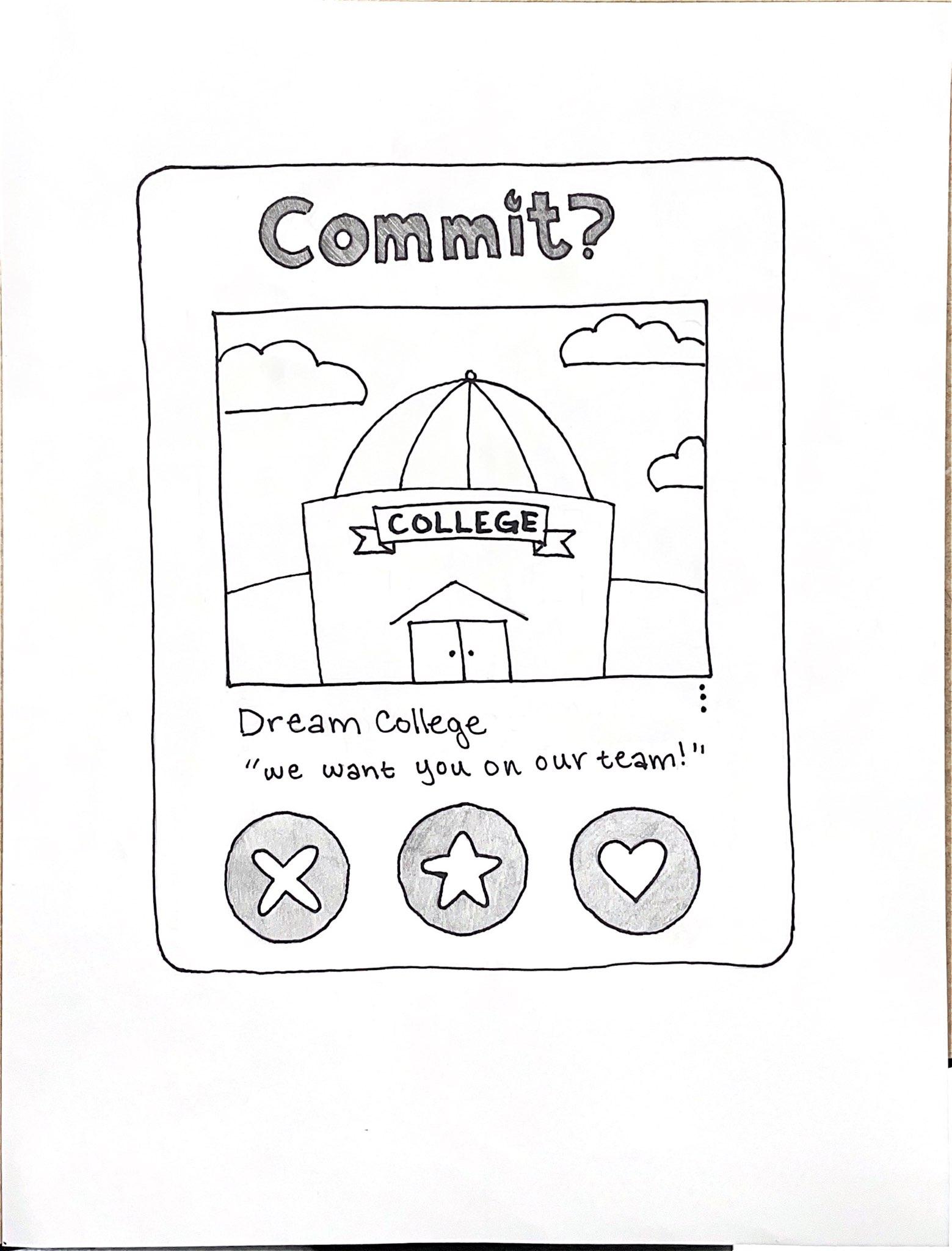
to them. I’m talking to them about what I want in a school and what they want in a player.”
A lot of athletes choose to begin the process during their ju nior year of high school. Reaching out to schools early can show interest and that can be appealing to colleges. It also can help with forming stronger relationships, so when it is time for them to commit, they already have a good idea of what the school, the coaches, and the team they will be joining are like.
So now you’re talking to some coaches. You really like them. After making connections, coaches will most likely want to meet you and come to a game, meet, or race to watch how you perform. Athletic director at ORHS Andy Lathrop said, “that’s a good sign for the athlete [when college coaches] come and watch [because] that means they have interest in you.”
When it came time for coaches to come to one of Pavlik’s games, she said, “at the beginning it was a little stressful, but once I started playing I’d stop focusing on that and start focusing on the game and playing my best. As it got more normal and got to the point where most of the tournaments I was playing in, there would be college coaches, it didn’t really bother me.”
Many students like Spencer, Pavlik, and Oake-Libow play
want people to judge me along the way. It’s really nerve rack ing.” She also mentioned that she has been working extra hard in school. She said, “[I’m not someone] where no matter what grades I have, I’ll be fine. Every school that I want to go to is pretty competitive so keeping up grades and balancing lacrosse life is a little difficult.”
So you’ve made it through and a few schools are really interested in you. Time to celebrate, right?! Not exactly, now it’s decision making time. Of course, you wouldn’t want to lead any schools on. This decision has many factors. Lathrop said, “some times it takes some trial and error, visiting schools, meeting coaches to narrow it down.”
Spencer said, “I actually didn’t see myself committing to UConn at all.” It’s a school that she had known all her life since both of her parents went there. She narrowed her top three down in December of 2020 with UConn on that list. Spencer said UConn ended up winning her heart because of, “the UConn coach… I liked what he said the best about his team and what his philosophy was. That felt like the best fit.”
Pavlik’s decision to commit to Pace University also came down to the coaching staff. “I ended up really liking [the coach]
it takes some trial and error, visiting schools, meeting coaches
for club teams. These teams can be an important part of the committing process for many athletes. Pavlik said, “I started [the committing process] pretty early because the club I play for does a lot of recruiting stuff. The head coaches are all college coaches and they have a lot of connections.”
Club teams can also be a great resource because older team mates may have gone through the same process. Oake-Libow said, “Three of my [club] team members committed in the past two weeks… It’s really cool seeing them going to all these great places.” Teammates who have already been through the process can help by being a role model and answering questions for their younger teammates who are beginning the process.
Sometimes you will be emailing with coaches and they might lose interest (A.K.A losing feelings). This can be hard and can knock your self confidence but Spencer said, “even if you’re invested in a school that says ‘no,’ keep them updated. Just keep pursuing them because sometimes things change.” She also rec ommended to “talk to as many coaches as you can and reach out to a lot of schools because you’re going to get a lot of ‘no’s.”
It can also be hard to tell whether you’re good enough or if they even want you. Oake-Libow said, “I feel semi-stressed be cause I don’t want to fall behind in the process and I [also] don’t
and her coaching style. I’ve been to campus a couple of times and I really like it. I’ve met a couple players from the team and I like the team. They just have pretty much what I was looking for,” she said.

So now congratulations are in order and it’s time to celebrate. You’re engaged! I mean verbally committed… After you’ve made your decision, you and the coach will talk and they will hopeful ly propose the idea of you committing to play for them and con tinue your education at that school. Around November is when your signing ceremony will take place. Lathrop said, “we’ll do signing days where, once [an athlete] commits to a school, we’ll have their parents come in and we’ll set up a table, take pictures, and they’ll sign their letter of intent.” A nice moment to celebrate your commitment!
After this year-plus long relationship, you’ve finally settled down. Now you get to celebrate all of the hard work you’ve put in and look forward to the next chapter of your life with your dream school. So it seems like dating and committing to a col lege aren’t that different after all.
- Libby Davidson“Sometimes
to narrow it down.”
The “Right” Whale to Kill
With less than 400 remaining in the global oceans, the North Atlantic Right Whales need our help! The North Atlantic Right whale has been critically endangered since the 1970s with a ma jority of the deaths being human caused. The main issue is that, while it is a human caused environmental crisis, almost no one

Since then, the Right Whale population has continued to deplete. The leading causes of death are the result of human impact.
Now that I have thrown this information at you, it begs the question: So what? As a community, I think we’re pretty envi ronmentally conscious and aware of local issues. However, there is a severe lack of knowledge and interest in the North Atlantic
knows anything about it, despite their critical habitat being off the coast of New England. However, the Oyster River commu nity can help protect the Right Whale population by supporting political candidates that vote in favor of marine conservation, learning about the issue, and buying from the local fishing industry.
Right Whales were, sadly enough, the “right” whale to kill due to their accessibility and buoyancy after death before whaling was outlawed in 1972 by the Marine Mammal Protection Act.
Right Whale issue, especially considering the two leading causes of death after climate change are ship strikes and entanglement, both human caused. According to Oyster River student Lex ie Frangos, “Before I took Marine Biology, I didn’t know they existed. I’d heard the name before but I didn’t know what they were or their migrational patterns and how they’re being affected by humans.” This further proves that the North Atlantic Right Whale issue is going unnoticed and addressed by even more
“In recent years, particularly with Right Whales, one of the issues we have faced is that they have changed where they are geographically by season [when they are] chasing different food. Basically, we can tie that to climate change and water temperature change. . . suddenly they’re in a place that they weren’t”
aware communities like ours at Oyster River.

People should pay attention to the endangerment of Right Whales because it is critical to ensure the biodiversity of our marine ecosystem. According to National Oceanic and At
number of traps in between the two buoys. The drawbacks to this method is that there is more weight and therefore more strain on the boats to pull the traps. NOAA is also working on new technology to create buoys that stay on the bottom until a
mospheric Administration (NOAA) employee Mark Grant, “Everytime you remove a species from an ecosystem, that ecosystem becomes less resilient overall. In its natural state every ecosystem is a form of chaos, it’s constantly changing, but almost everything in there is flexible to a certain point. [That] also means that if something, [for example] cod, normally preys on isn’t available, it preys on something else. If you start taking all those pieces away, that ability to shift big picture starts to go away.” The extinction of the North Atlantic Right Whale would not just be a tragedy because of the loss of such a beautiful ani mal but would also make our ecosystem less resilient and able to adapt as a whole. So, while you may not think this issue impacts you, their extinction would create would be one more loss to the already struggling ecosystem we live in. This ecosystem became more at risk a few years ago when Right Whale deaths spiked.
These deaths spiked when the fishing community came into contact with whales in areas they weren’t typically in that time of year. This may not seem like a big deal, but even 10 deaths is significant in a population of less than 400 according to the “Re covery Plan for the North Atlantic Right Whale” by the NOAA. Grant says, “in recent years, particularly with Right Whales, one of the issues we have faced is that they have changed where they are geographically by season [when they are] chasing different food. Basically, we can tie that to climate change and water tem perature change. . . suddenly they’re in a place that they weren’t.” The problem this presents is that ships are unprepared to deal with them and lack the equipment needed at that time of year.
The biggest issue locally is limiting vertical lines, which directly affects the lobster industry that is so prominent in our community. The vertical lines are long ropes that attach between a lobster trap at the ocean floor and a buoy at the surface. While this makes it easier for lobster fishermen to locate their traps, the vertical lines can entangle whales and injure them or, in more severe cases, drown them. Grant explained, “it could in terfere with feeding, it might slow them down, [or] it might just wear them down and make them susceptible to other disease. It can also make it harder for them to avoid a ship and get struck.”
The fact of the matter is that this is the second leading cause of death, second only to climate change, and New England makes up a large part of their habitat. If we don’t start taking respon sibility as a community, chances are the North Atlantic Right whale will be extinct within our lifetime.
The recent regulations on the fishing industry seek to limit vertical lines and enforce break links and pingers in gill nets. One way to limit the number of vertical lines is to increase the
certain frequency is released and then they float to the top. This would eliminate the danger to marine mammals because the lines would only be there for the amount of time it takes to pull the traps. However, with all new things, there are drawbacks.
While NOAA takes into account feedback from the fishing community, the new regulations are not getting much support. “There is a lot of controversy about that. Obviously fishing is money and particularly lobster fishing in the Gulf of Maine is really big business, so at a minimum, just changing that gear is expensive. Then beyond that if the gear is either less efficient at catching their target or if it’s more work to handle it on deck that’s an additional cost or problem for industry. So, there’s a lot of concern about the recent changes to deal with that,” said Grant. I think it’s important to point out that this is a complex issue that needs to take into account the industry as well as the Right Whale issue. By attending meetings held by NOAA to hear community feedback and supporting legislators or their campaigns that support the new regulations, you can impact the trajectory of human interactions with the species as well as hear the voices of the local fishing industry.
As for what the Oyster River community can do, we can buy American seafood because the U.S. has laws and regulations to protect marine mammals. While this may seem counterintuitive because of the issues with the lobstering, we know for a fact that the Maine lobstering industry has enforced restrictions to protect marine mammals that other fishing industries don’t nec essarily have. You can also go on non-profit whale watches in the area through the Blue Ocean Society. Even simply educating yourself on local conservation issues can make a big impact.
The biggest thing our community can do is support can didates who pass legislation for environmental and marine conservation. By signing a petition on the Blue Ocean Society website, sending a donation, or simply sharing a link to a speech supporting bills like the Marine Mammal Protection Act, you can impact the future of the species.
- Annie Doherty PhotobyEliseRiddell“Before I took Marine Biology, I didn’t know they existed. I’d heard the name before but I didn’t know what they were or their migrational patterns and how they’re being affected by humans.”
The Real Right to Freedom from Discrimination in Education
At the beginning of the 2020-21 school year, Oyster River founded a Diversity, Equity, and Inclusion (DEI) committee dedicated to addressing racism and other forms of prejudice in our community. Like in many school districts across America, this committee was created partially because of the increased public awareness of the urgent need for societal change after George Floyd’s murder last spring.
Unfortunately, progress always seems to be accom panied by pushback. State legislatures across the country have approved bills intending to stop all recent progress in its tracks, and New Hampshire is no different. Embedded into our state budget is a section about the “Right to Freedom from Discrimination in Public Education.” Despite its mislead ing title, this law does nothing to pre vent discrimination in public education. Instead, it does quite the opposite. At tempting to reverse recent advancements towards inclusion, the law restricts and limits how we can talk about issues in our country and severely threatens those who violate it.
The so-called “Right to Freedom” law includes language prohibiting professional trainings and lessons in public schools from teaching that members of any “age, sex, gender identity, sexual orientation, race, creed, color, marital status, famil ial status, mental or physical disability, religion, or national origin” hold implicit biases against another given group. It also bans teaching that people in these groups should not treat one another equally or are incapable of treating each other with respect. This is not an idea taught anywhere, but the law is written so vaguely that it forces teachers to walk on eggshells

to avoid misinterpretation of their classes. Perhaps the scariest part of the law is its punishment: if a teacher is found by the courts to have violated this law, they will lose their license to teach.
According to Oyster River superintendent Jim Morse, this direct threat to educators “sets a negative cloud over the teach ers across New Hampshire, making them question whether they are teaching in defiance of the law.” He says before presenting a lesson, teachers must ask themselves, “does the law make sense to the instructional program they’ve put together? How does that all fit into teaching a genuine history of the United States?” Morse says this confusion is compounded by the fact that “the law itself is both specific and vague, and so it’s hard to navigate what it does and doesn’t mean.” The law has not been tested in court yet, so many educators are apprehensive about stepping too far outside of what has traditionally been taught, because nobody knows quite how far the law reaches.
That said, with the right precautions, it is possible this law won’t be as detrimental as many fear. ORHS social studies teacher Nate Grove says that he doesn’t believe his class will be affected very much by the law. He says that his classes, like the rest of his department, don’t push the idea that white people are to blame for everything. Instead, he encourages students to look at quotes and documents from history and then draw their own conclusions. He says, “If we have a problem, it’s likely be cause of misinterpretation or political maneuvering by outside groups in order to present or make a political point. So, I really
don’t think we’re going to have an actual problem — though we may have a problem of inconvenience if someone decides that they just want to go after [teachers].”

Still, this problem of inconvenience that Grove describes could be devastating to the effort to make education across our district antiracist and inclusive. Even if they aren’t violating the law, teachers can’t control how their lessons are interpreted by students and their families. In countless conversations I’ve had as a student representative on the DEI committee, many teach ers have confided to me that this law has deterred them from incorporating more social justice into their classrooms. While they do care about antiracism and teaching accurate history,
exists. As a result of living in a prejudiced society, all people have implicit biases about each other. This isn’t saying we are bad people or are incapable of treating others with respect, it’s simply acknowledging that racism, sexism, and other forms of hostility towards certain groups are present in our society, and this has had an effect on our subconscious beliefs.
Understanding implicit bias is vital to understanding history. It is a key reason for why discrimination has existed and continues to exist in America, because it causes people to accept things as they always have been. If implicit biases go unrecognized, they can prevent us from seeing the wider causes and effects of societal issues. This is why the law is so scary: if
teachers are fully aware of how rhetoric around laws like this has politicized social justice work. As a result, educators are scared of being brought to court over a misunderstanding — or worse, so someone can make a political point — and then losing their jobs. Many of the teachers who were already on the fence about this work have been dissuaded even further from learning more, because they don’t see this threat on their jobs as worth the effort of learning about how to incorporate DEI initiatives into their lessons.
Luckily, the ORCSD administration recognizes this issue, and is doing everything it can to support teachers. Morse has had several meetings with the district attorneys to try to under stand exactly what teachers can and cannot do. The attorneys even spoke directly with Oyster River teachers at the beginning of this school year — something that has never been done before. This meant that teachers could hear firsthand what the law restricts in their classroom and how they can safely teach without violating it.
Morse has also provided guidance to teachers on how to respond to parents who wrongly believe they have broken the law. Part of this guidance includes encouraging teachers to write clear lesson plans which detail the goals of every class, which will hopefully help parents (and general courts, if it gets that far) understand that the intent of a class was education, and not indoctrination.
Nevertheless, the district can only do so much about protecting teachers when the law specifically restricts certain course content, namely the discussion of implicit bias. Also known as unconscious bias, implicit bias is a prejudice some one holds and acts on without consciously realizing that it
we are not allowed to examine our blind spots, we will not be able to see the truth of our nation’s history. Our government is attempting to prevent us from learning about its failures using this law. Even though it claims that “nothing in this section shall be construed to prohibit discussing, as part of a larger course of academic instruction, the historical existence of ideas and subjects identified in this section,” the law directly contra dicts this by stopping us from learning perspectives which will help us examine history more clearly.
Additionally, Oyster River classes teach us that we are living history, but this law draws a hard line between past and present. How can we learn accurate history if we cannot also connect it to the present day? Banning discussion of a concept which is crucial to our understanding of racism and other discrimi nation in America prevents us from getting the best and most accurate education possible.
As students, it is our responsibility to fight back for the true and honest education we deserve. Grove says, “Anyone in this country really can speak up and speak out. There are protest marches, there are ways that students can organize petition campaigns, letter campaigns, email campaigns. Students can, of course, talk with adults, although I know that it can be scary. We’ve also seen where students have done it, in our country and in other countries, where they have younger people who don’t yet have the right to vote, but do have the opportunity to wield social and political clout.” In the face of racist and discrimina tory laws, we have both the power and the obligation to protect our right to an accurate and all-inclusive education, so let’s tak initiative and get involved to build a truly free education.
- Zoe Selig
“Anyone in this country really can speak up and speak out.”
If we are not allowed to examine our blind spots, we will not be able to see the truth of our nation’s history. Our government is attempting to prevent us from learning about its failures using this law.
Our Passion Needs to Get More Compassionate
A guide to improving our conversations about politics

Last spring, Alden Swiesz wrote an MOR article entitled “A Different Perspective,” which detailed his experiences as a conservative student in the majority-leftist Oyster River School District. He talked about the isolation and discomfort he felt from having different political views than many of his peers. As a member of the Diversity, Equity, and Inclusion committee, event coordinator for the ORHS Young Democrats, and gen erally politically active liberal student, I heard a lot about this article when it was published. Friends, family members, and participants in my various clubs all forwarded this article to me and asked for my position on it. My response shocked them: I completely agreed with what Sweisz was saying.
In my experiences throughout middle and high school, al most every political conversation I’ve observed has turned into a debate. This is understandable; between our country’s polar ization, our culture’s tendency to tie opinions and identity into one, and the difficult topics being discussed, it’s easy to become fiery and turn a friendly talk into a shouting match. I’ll admit, I’ve absolutely done the same thing and lost my temper at peers for saying one too many things I disagreed with. However, shouting insults is not the method to choose when attempting to convince someone to agree with you. As politically-minded students, we need to use more compassion when talking to classmates of different views than our own.
Let me be clear, I’m not saying that we should pretend to agree with everything somebody says, or that we need to excuse
bigotry and offensive remarks. Compassion does not mean concession. I’m saying that we need to prioritize the opposing party’s humanity above their political affiliations. Too often, students will hear one buzzword that sets them off into a slew of insults and causes them to refuse to listen to anything the other person has to say, which completely eradicates the possi bility of having a productive discussion.
Not only does this prevent our conversations from being helpful, but it also takes a toll on students who hold different views than the majority of their classmates. In Sweisz’s article, he details hiding his Republican beliefs and pretending to be a Democrat in his citizenship education class, an experience repeated by many of the other conservatives he interviewed. Students should never be made to feel ashamed of their political opinions in social or classroom settings. We need to make sure that all students in Oyster River feel safe expressing themselves in order to truly consider our school a welcoming community. Additionally, ensuring that every student is com fortable sharing their opinions will strengthen the quality of our political discussions, because it will allow people to express their genuine thoughts rather than what they feel pressured or expected to say.
So, how do we improve our discussions about politics? Award-winning journalist Celeste Headlee says it best in her TED Talk “Ten Ways to Have a Better Conversation”: “You need to enter every conversation assuming that you have something
to learn.” We can’t go into a discussion with someone under the assumption they are a mindless echo of the things they’ve heard, who after hearing our point of view will suddenly see the light and agree with us wholeheartedly. People have reasons behind every belief they hold, and we can only change those beliefs if we first connect with the reasonings behind them.
Right-leaning student Zach Serrano (‘22) adds to this point. “You just have to understand that everybody is coming from different lifestyles. Once the right and left can see that, ‘Hey, these people are coming from somewhere else,’ and once you understand where they’re coming from and why they think the way they do, then you’ll be able to sympathize with their position more and respect what they’re saying more. After that, you’ll be able to actually find better solutions. Once you un derstand them, you can understand the problem at a different level.”
Discussing controversial topics and remembering to bring compassion to the forefront takes a great deal of effort and practice. When somebody is speaking on a topic and you are against everything they’re saying, it can be hard to remain open-minded. One strategy that helps keep open-mindedness as the focus is to set guidelines, either unspoken for yourself or spoken between participants in a conversation.
Paxton also finds that being knowledgeable about a subject allows her to discuss it better. “I haven’t always been kind, I haven’t always understood what other people are talking about, and that’s when I have to take a step back and really do research. I have very strong political views, and I do a lot of research to develop those, and there are a lot of times where I haven’t researched as much what other people are thinking or talking about.” Learning more is always a good idea, but espe cially on controversial topics like politics, where the issues are so multifaceted that having a thorough understanding of them is crucial to a discussion. Knowing a lot about a given topic allows for a more objective and fact-based conversation, rather than one driven solely by emotions.
Putting all of this effort and self-control into our discussions is challenging, but essential to building a better school and world environment. Serrano gives an example of a time when his viewpoints should have been given this type of consider ation, but weren’t. On his eighth grade trip to Washington, D.C., Serrano bought a Make America Great Again hat, and in hindsight he is aware of how that was negatively interpreted by many of his peers. When one classmate brought up their issues with his hat, Serrano started having a peaceful conversation with them about it. However, another classmate was imme
For example, sometimes I’ll find myself talking to somebody I disagree with and will consciously decide not to use any de meaning terms, or I’ll deliberately separate my past experiences from the present moment so I can have as much empathy for the other person as possible. I find that every time I do this, I’m left feeling more well-educated on the subject than I was before. Other times, a conversation will get heated and I’ll say to whomever I’m speaking with that it is not okay to use a certain phrase, and that we can only continue the conversation if they don’t use it again. The key to this strategy is following through; it only works if I don’t use the degrading words or actually walk away when the person uses the phrase I’ve identified as off-lim its. It’s also important to embrace the other person’s boundaries: showing respect for other people’s wishes will make them much more likely to hear out your point.

Elsie Paxton (‘23) considers herself a progressive Demo crat and says that another use for these guidelines is that they identify “what’s considered an opinion and what’s considered a human right.” She says that these are needed in conversations about politics, especially where recent political divides have blurred the lines between the two. It’s okay to disagree about things like healthcare and how to address certain social issues, it’s another thing altogether to be homophobic or racist. If a specification between the two isn’t made, it allows hate-speech to be written off as acceptable, and lets the person making the hateful statements continue on as though those statements are okay.
diately dismissive of Serrano’s point of view, and pulled the person he was speaking with away, declaring, “Stay away from the Trump supporter!”
Serrano says that this moment “really hurt me, personally. I felt like I was having such a productive conversation with this kid, and although we were disagreeing on just about every thing, we were reaching this mutual understanding. What that student did just completely pulled the conversation away from any productivity that we had.” Had this student not dragged their friend away, it is likely that either Serrano or the person he was speaking with would have changed their viewpoints, or at least walked away from the conversation with an expanded understanding of each other. Instead, they were left in the same state of political polarization as they had begun, which just goes to show how vital open-mindedness in tough conversations
making progress.
Finally, I want to emphasize that this applies to everyone. If not all political conversations have the goal of mutual under standing, then it will be impossible to achieve. Instead, all that will happen is more conflict, with no resolution and so many concessions from one side that resentment is heightened instead of removed. However, if all of us together decide to lead our politics with compassion, we can improve our school
- Zoe Selig Art by Hannah Muessigis to
culture for everybody.
“You just have to understand that everybody is coming from different lifestyles. Once the right and left can see that, ‘Hey, these people are coming from somewhere else,’ and once you understand where they’re coming from and why they think the way they do, then you’ll be able to sympathize with their position more.”
So Much Work for So Little Money
It is almost a daily occurrence for someone like me who wants to become an elementary school teacher to be told I won’t make money.
“Go into the trades so you won’t be poor.”
“You sure you want to be a teacher? It’s not a lot of money for a whole lot of work.”
“Make sure you marry rich or you will be living on the streets.” These are all things I hear when I tell someone I want to go into education as a public school teacher. If you think about it, why are teachers paid so little compared to other professions? Teaching is actually a prerequisite for getting other jobs. According to “Public School Salary in New Hampshire” from Salary, the average New Hampshire public school teacher earns around $60,423 per year. Considering they play such an important role in society, teach ers have very low salaries. For years, teachers have been known to have low salaries, especially those who major in education. I believe things for teachers need to change now and their salaries need to be higher.
A child’s life begins to be molded by their teachers as early as the age of five. I still remember the names of every single one of my teachers. Children form lifelong mem ories through teachers, yet teachers are underpaid. For me as a young student with anxiety, I struggled during school. My second-grade teacher made such a large impact on me that we still stay in touch to this day. I used to struggle with my handwrit ing so each morning when I would go into the classroom there would be a new pencil to help my handwriting. She helped me through some of my hardest years, and I hope to be half of the teacher she was in the future. Other students at ORHS such as Ellie Koener (‘22) agree saying, “Teachers are the basis for our careers so if you grow up and make more than a teacher I think that’s wrong.”
Teachers are not only important for memories but mental health too. During my years in middle school, I began to struggle with anxiety. With not many people to turn to while in the school building my science teacher took me under his wing. He made me feel comfortable enough to speak up in class and even helped me build a community for myself. Still to this day, I believe I would not have made it through my eighth-grade year without him. Even teachers realize how much of an impact they have on stu dents’ mental health. “School and teachers have such an influence on your socialization process of helping you be who you are,” says Gabrielle Anderson, a social studies teacher at ORHS. She teaches core classes such as World Cultures and U.S History but also elective courses like Sociology.
Teachers have such a prominent role in children’s lives and sometimes children don’t get what they need from teachers. Jobs that offer a higher salary are more likely to attract teachers that
went to school and paid high amounts of money for a degree. Ac cording to “The Neuroscience of Joyful Education” from Educa tion Leadership, “When students are engaged and motivated and feel minimal stress, information flows freely through the affective filter in the amygdala and they achieve higher levels of cognition, make connections, and experience “aha” moments.” Students need meaningful connections with teachers and when they have them there are lifelong advantages. For me when a teacher makes a comfortable and fun learning environment I will be more willing to listen and retain the information.
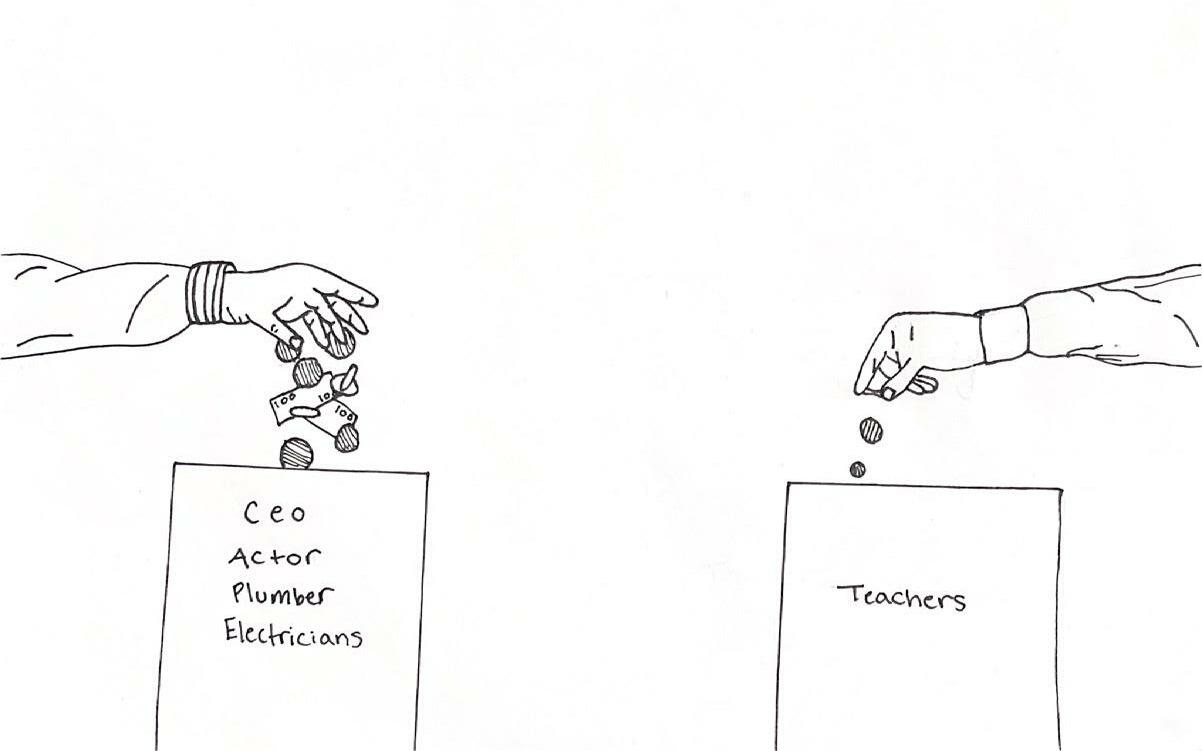

However, in rural parts of the country, it can be hard for them to get teachers who are willing to create those environments be cause of the pay. “I started my career teaching in rural New Mex ico and the teachers’ salaries for a first-year teacher was $18,000 a year,” says David Hawley, a social studies teacher at ORHS. Hawley also spoke about how each district pays depending on state funding and how wealthy the community is. In order to help teachers’ salaries, Hawley believes we have to find ways to help the rural areas that do not have as much funding. I believe that we can help these districts all across the country by pin pointing districts in need and what exactly they need. Then provide them with the resourc es they need by supply drive or fundraisers. This may result in the school having more extra money to give to teachers.
According to “The Status of Rural Education” from The National Center for Education Statistics, “On average, public school students in rural areas perform better on the National Assessment of Educational Progress (NAEP) than their peers in cities and towns but generally not as well as their peers in sub urban areas. Typically, suburban areas such as Durham teachers have higher salaries but this does not mean that every teacher with a high salary is looking out for their students. This also does not mean that all teachers in rural districts have no experience. Though the statistic gives me hope that children in rural districts are getting the education they deserve meaning soon we may see a change for them.
For teachers in New Hampshire, I think it is important we talk about teachers’ salaries and how low they really are. For all the work, time, and effort teachers put into their work something needs to be done for them. This is a large problem for teachers everywhere and I believe the first step to changing life for teachers is for districts to focus more on budgeting for teachers’ salaries. Instead of focusing on a new gymnasium or a new sports field the priority is to increase pay for teachers. Not only as a state but as a county we should be focusing on the budgeting of schools to incorporate more room for teachers’ salaries to rise. If we as a country continue to speak up and push for higher salaries for teachers maybe in the future there will be a change.
-Emily Jackman




